Essay for Primary School: Simple Guide for Kids [with Samples]
The age of primary school students ranges from 5 to 11 years. At this stage of education, children start developing their writing skills. They make their first steps to analyzing and proving their points of view. Besides, they study how to write an essay for elementary school.
Correctly preparing all types of homework, from creative to persuasive writing, is something they should learn how to do. Surely, they need assistance in completing the first tasks. Right now, we will present to you the essentials of a good essay for primary school:
- A captivating topic;
- A precise and clear thesis statement;
- Several introductory sentences;
- Several supporting sentences;
- A strong concluding part.
If now you are looking for some hints for writing primary school essays, you have come to the right place. Especially considering the fact that children may approach the task in a variety of ways depending on how they prefer to study (which is easy to find out by taking a learning style quiz for kids). Below, our team has prepared tips and tricks for kids to nail their primary-level academic papers.

💡 How to Write an Essay for Primary School
An essay is one of the first written assignments you may get. So, we advise you to pay special attention to what your teacher says. Before assigning such a task, they give you explanations for preparing a primary school essay.
Usually, elementary school essays are meant to fire up kids’ imagination and expose their writing skills. No matter what the purpose is, you should approach the task with care.
What should an essay for primary school include?
- A captivating topic ; Selecting a topic is the first thing you will do after you get your assignment. Carefully examine the task’s details and think about something appropriate for your elementary level. Brainstorming your ideas is an excellent place to start.
- A precise and clear thesis statement; Make sure your thesis statement is accurate and brief. Without a clear thesis, your essay will not have a central idea and will be hard to develop. A precise statement tells the reader what your writing is about. Besides, it exposes how good your grip on the central idea is.
- Several introductory sentences; A great introductory paragraph can help you grab your readers’ attention. You can start by including a quote, telling an anecdote, or asking a question. In the introduction, the author also identifies the purpose of the essay and the topic. The paragraph ends with a thesis statement and prepares the reader for the supporting sentences.
- Several supporting sentences; This part of your essay will include the position you presented in the thesis statement. It will either offer an idea or defend it. It can be done in several ways: you can include reasons, examples, and supporting points.
- A strong concluding part. The conclusion wraps up the essay, but it emphasizes all the principal points you have argued throughout your essay. It is the last chance to sway your reader by explaining why the topic is relevant to them. Ending your essay with a strong concluding part shows that the thesis statement has been defended.
Essays for primary schools do not require research or analytical data. All you need is to present your ideas on the specified or chosen topic. Mind the proverb, “the written word remains” while writing your first elementary level essay.
The thing is:
The essay structure explained above will work for assignment kids will face in elementary school, middle school, high school, and up to college level. Teaching kids to write a traditional five-paragraph essay is essential for their academic success. It helps explain to them how to argue their ideas in a coherent and structured manner.
If you need more help with writing essays or with essay proofreading , you are welcome at our site.
✨ Topics for Primary School Essays
See the primary school essay topics that are manageable for an elementary level. It should be interesting for a kid but also informative and engaging for the readers.
These topics will get an A+ for your next school assignment:
- Our world in 50 years;
- My first day at school;
- Future profession;
- My summer holidays;
- My journey through primary school;
- When I grow up… etc.…
You can find a good topic but have no idea how to write a good paper on it. These five essay prompts can be helpful if you need some inspiration.
- What is your favorite day of the week, and why? Think about a day of the week you enjoy the most. Why do you like it? Most of us wait for weekends to rest and spend time outside and with our families and friends. If that’s your case, describe how your usual Sunday looks and explain why you enjoy it.
- What do you like the most about winter? This is another great topic to consider, especially for creative writing. Everyone can pick at least several things they enjoy about winter. Whether it’s the snow, the winter sports, the holidays, or the winter break, write about something you like. It’s a fun and engaging topic for everyone.
- Who’s your hero? All of us have a person they admire. It can be your father, your friend, or a celebrity. Think about the qualities or their actions that make them so special. You can try to tell a little bit about their biography and explain how they influenced you.
- What’s a good friend? You probably have a best friend. In this essay, you can try to explain what qualities do you personally appreciate in them. If you haven’t found a best friend yet, you can try to think about what kind of people you enjoy interacting with.
- Your biggest dream. People are born with the ability to dream. What is your biggest dream? Is it to learn how to drive a boat or visit savanna and see the big five? This essay lets your imagination and your creativity run wild.
- The car I dream about.
- Explain what friendship means to you.
- Describe your parents.
- How do you understand happiness?
- Write how you help your classmates with autism to feel included.
- The most important event of my childhood.
- Discuss why physical activity is important for children and what types of activity you like best.
- Do you like to take part in competitive sports?
- Explain why you like or don’t like figure skating.
- A person who inspires me: my mother .
- What dog would you like to have?
- Describe your visit to Disneyland or any other theme park.
- My travel to Dresden.
- What challenges did you face in primary school?
- Do you believe in online-friendship?
- What do you do when you feel stressed?
- Tell about your puppy and how you take care of it.
- The reasons my teacher is the brightest figure in my life.
- Describe the kindergarten you went to and explain why you liked or didn’t like it.
- How did you deal with bullies in the kindergarten.
- How I won the fight by losing it .
- Write about your favorite primary school teacher.
- Why everyone should have a pet .
- Explain how you interact with other kids at school.
- Tell about the most exciting event in your life.
- Explore how eating healthy food can help you to do better at school.
- Describe your first visit to a museum.
- The difference of being a child in the past and today.
- Write about your trip to Yellowstone National Park and what you liked the most about it.
- What makes a good parent?
- How does your dream home look like?
- Do you remember what difficulties you faced while learning to write?
- Tell about your favorite holiday.
- What do you like about Christmas?
- How I learned to ride a bicycle.
- Describe the lessons you have in primary school and which of them is your favorite.
- Write about your physical education teacher.
- Discuss the pre-school education facility you’ve visited.
Sometimes such prompts can help you better than primary school essay writing samples. First of all, it gives you a direction by leaving you with the questions that only you can answer. Second, it shows you a variety of topics and themes available. Nevertheless, we still encourage you to look at some simple essays for primary school for better results.
All in all:
Essays are the most common academic paper that might seem easy to a writer. Our free tips will help you to get through any kind of paper. Still, if you are stuck on essay writing, you can always ask us for help!
Thank you for reading the article! Share it with peers and leave a comment below to let us know your opinion.
Further reading:
- Essay Topics for Grade 8, 9, 10, 12
- What Does an Excellent Essay Look Like?
- 1000-Word Essays: Quick Answers
- Breaking Down the Types of Essays
- A Complete Guide to Essay Writing
- How to Write a Good 5 Paragraph Essay
- The Basics of Effective Essay Writing: Becton Loveless, Education Corner
- 50 Writing Prompts for Elementary School Children: Janelle Cox, ThoughtCo
- Student Writing Models: Thoughtful Learning K-12
- Elementary Archives: JournalBuddies.com
- Share to Facebook
- Share to Twitter
- Share to LinkedIn
- Share to email

Canadian identity is something that has become really important for many Canadians in the past fifty years. Canada is a big, multinational country with its own traditions, culture, and history. However, because of quite a large number of foreigners and even Americans, its culture and people are associated with the...

Let’s say you received a task to write an essay about cars. The topic might be interesting for you, but you may still have no idea how to organize your paper. Well, this article is for you.

Smoking can be viewed as one of the trendy habits. Numerous teenagers try it since they think that it is cool or can help them socialize. Often students start smoking due to stress or mental illnesses. But is it okay? Educators tend to give different written assignments, which may disclose...
![how to write essay for primary school Child Labor Essay: Thesis, Examples, & Writing Guide [2024]](https://custom-writing.org/blog/wp-content/uploads/2020/12/child-working-in-cambodia-e1565628499749-284x153.jpg)
Children have always been apprentices and servants all over human history. However, the Industrial Revolution increased the use of child labor in the world. It became a global problem that is relevant even today when such employment is illegal.
![how to write essay for primary school French Essay: Topics, Tips, and Examples [2024 Updated]](https://custom-writing.org/blog/wp-content/uploads/2020/12/french-woman-with-baguettes-street-beret-284x153.jpg)
Nowadays, knowing several foreign languages is no longer surprising. For example, learning French is common for English-speaking countries. So, getting an assignment on this subject won’t be a surprise for a student.

Dissertation critique writing develops the students’ critical and logical thinking abilities. When composing, the students learn to analyze the works conducted by other researchers. To critique a dissertation, you should: In this article, we will discuss the aspects of the dissertation critique writing in detail. Our experts gathered essential tips...

An opinion essay is a formal piece of writing which presents the author’s point of view on a particular subject supported by reasoning and examples. The opposing viewpoint is also suggested, but it is followed by arguments that show its inconsistency. Take a look at the guide prepared by Custom-writing experts to...

So, you need to accomplish your discursive essay writing. The typical questions most students ask are: How do you write it? What is discursive essay? A discursive essay is an academic paper that involves a discussion on a particular topic. It is usually assigned to college students. You may be...

How to write a narrative essay? To do that, you need to know what a narrative essay is. It is an academic text usually written as a story and containing all the usual elements of a story. Narrative essays are often personal, experiential, and creative. Still, they should be made...
![how to write essay for primary school College Essay Writing 101—the Comprehensive Guide [2024]](https://custom-writing.org/blog/wp-content/uploads/2021/01/student-girl-making-notes-in-a-copybook-with-a-pencil-e1565634333206-284x153.png)
So, you can’t wait to get into college and join a fraternity, sorority, or student union. Well, we have some incredibly useful tips and helpful information for college admission essay writing! Remember: getting into college takes more than money. And outstanding essays get you great college scholarships!
![how to write essay for primary school Americanism Essay: Examples, Tips & Topics [2024 Update]](https://custom-writing.org/blog/wp-content/uploads/2020/12/american-flag-284x153.jpg)
It’s not hard to see why Americanism is one of the most popular essay topics. The concept of Americanism is in the center of the US identity. Writing an essay about it is an excellent way to find out more about this great country.

An art critique paper involves a comprehensive analysis and assessment of an artwork. Though this looks a bit complicated, the task doesn’t require a lot of time if you have sufficient critique writing skills. It’s an interesting assignment for students of art colleges as well as high schoolers. All you...
Being a primary school teacher of English language, I have discovered that many students leave primary school without basic essay writing skills. This is because as teachers, we do less to help and guide the learners in this aspect. We do less because we lack the knowledge and ability to guide the learners perfect this writing skills yet it is considered the production stage of language learning. Kindly help me. Guide me further so that I can also guide my learners.
A great suggestion for primary teachers and parents!
This is a very good method to preach the acknowledgments on report writing towards people.
Thank you for your great effort and help. Your blog has taught me many things! Thanks for this fantastic blog post on writing primary school essays.
Thanks for the post on writing essays for primary schools. It’s a real help for me and my son, who just starts to learn how to write essays.

Essay Writing: A complete guide for students and teachers
P LANNING, PARAGRAPHING AND POLISHING: FINE-TUNING THE PERFECT ESSAY
Essay writing is an essential skill for every student. Whether writing a particular academic essay (such as persuasive, narrative, descriptive, or expository) or a timed exam essay, the key to getting good at writing is to write. Creating opportunities for our students to engage in extended writing activities will go a long way to helping them improve their skills as scribes.
But, putting the hours in alone will not be enough to attain the highest levels in essay writing. Practice must be meaningful. Once students have a broad overview of how to structure the various types of essays, they are ready to narrow in on the minor details that will enable them to fine-tune their work as a lean vehicle of their thoughts and ideas.

In this article, we will drill down to some aspects that will assist students in taking their essay writing skills up a notch. Many ideas and activities can be integrated into broader lesson plans based on essay writing. Often, though, they will work effectively in isolation – just as athletes isolate physical movements to drill that are relevant to their sport. When these movements become second nature, they can be repeated naturally in the context of the game or in our case, the writing of the essay.
THE ULTIMATE NONFICTION WRITING TEACHING RESOURCE

- 270 pages of the most effective teaching strategies
- 50+ digital tools ready right out of the box
- 75 editable resources for student differentiation
- Loads of tricks and tips to add to your teaching tool bag
- All explanations are reinforced with concrete examples.
- Links to high-quality video tutorials
- Clear objectives easy to match to the demands of your curriculum
Planning an essay

The Boys Scouts’ motto is famously ‘Be Prepared’. It’s a solid motto that can be applied to most aspects of life; essay writing is no different. Given the purpose of an essay is generally to present a logical and reasoned argument, investing time in organising arguments, ideas, and structure would seem to be time well spent.
Given that essays can take a wide range of forms and that we all have our own individual approaches to writing, it stands to reason that there will be no single best approach to the planning stage of essay writing. That said, there are several helpful hints and techniques we can share with our students to help them wrestle their ideas into a writable form. Let’s take a look at a few of the best of these:
BREAK THE QUESTION DOWN: UNDERSTAND YOUR ESSAY TOPIC.
Whether students are tackling an assignment that you have set for them in class or responding to an essay prompt in an exam situation, they should get into the habit of analyzing the nature of the task. To do this, they should unravel the question’s meaning or prompt. Students can practice this in class by responding to various essay titles, questions, and prompts, thereby gaining valuable experience breaking these down.
Have students work in groups to underline and dissect the keywords and phrases and discuss what exactly is being asked of them in the task. Are they being asked to discuss, describe, persuade, or explain? Understanding the exact nature of the task is crucial before going any further in the planning process, never mind the writing process .
BRAINSTORM AND MIND MAP WHAT YOU KNOW:
Once students have understood what the essay task asks them, they should consider what they know about the topic and, often, how they feel about it. When teaching essay writing, we so often emphasize that it is about expressing our opinions on things, but for our younger students what they think about something isn’t always obvious, even to themselves.
Brainstorming and mind-mapping what they know about a topic offers them an opportunity to uncover not just what they already know about a topic, but also gives them a chance to reveal to themselves what they think about the topic. This will help guide them in structuring their research and, later, the essay they will write . When writing an essay in an exam context, this may be the only ‘research’ the student can undertake before the writing, so practicing this will be even more important.
RESEARCH YOUR ESSAY
The previous step above should reveal to students the general direction their research will take. With the ubiquitousness of the internet, gone are the days of students relying on a single well-thumbed encyclopaedia from the school library as their sole authoritative source in their essay. If anything, the real problem for our students today is narrowing down their sources to a manageable number. Students should use the information from the previous step to help here. At this stage, it is important that they:
● Ensure the research material is directly relevant to the essay task
● Record in detail the sources of the information that they will use in their essay
● Engage with the material personally by asking questions and challenging their own biases
● Identify the key points that will be made in their essay
● Group ideas, counterarguments, and opinions together
● Identify the overarching argument they will make in their own essay.
Once these stages have been completed the student is ready to organise their points into a logical order.
WRITING YOUR ESSAY
There are a number of ways for students to organize their points in preparation for writing. They can use graphic organizers , post-it notes, or any number of available writing apps. The important thing for them to consider here is that their points should follow a logical progression. This progression of their argument will be expressed in the form of body paragraphs that will inform the structure of their finished essay.
The number of paragraphs contained in an essay will depend on a number of factors such as word limits, time limits, the complexity of the question etc. Regardless of the essay’s length, students should ensure their essay follows the Rule of Three in that every essay they write contains an introduction, body paragraphs, and a conclusion.
Generally speaking, essay paragraphs will focus on one main idea that is usually expressed in a topic sentence that is followed by a series of supporting sentences that bolster that main idea. The first and final sentences are of the most significance here with the first sentence of a paragraph making the point to the reader and the final sentence of the paragraph making the overall relevance to the essay’s argument crystal clear.
Though students will most likely be familiar with the broad generic structure of essays, it is worth investing time to ensure they have a clear conception of how each part of the essay works, that is, of the exact nature of the task it performs. Let’s review:
Common Essay Structure
Introduction: Provides the reader with context for the essay. It states the broad argument that the essay will make and informs the reader of the writer’s general perspective and approach to the question.
Body Paragraphs: These are the ‘meat’ of the essay and lay out the argument stated in the introduction point by point with supporting evidence.
Conclusion: Usually, the conclusion will restate the central argument while summarising the essay’s main supporting reasons before linking everything back to the original question.
ESSAY WRITING PARAGRAPH WRITING TIPS

● Each paragraph should focus on a single main idea
● Paragraphs should follow a logical sequence; students should group similar ideas together to avoid incoherence
● Paragraphs should be denoted consistently; students should choose either to indent or skip a line
● Transition words and phrases such as alternatively , consequently , in contrast should be used to give flow and provide a bridge between paragraphs.
HOW TO EDIT AN ESSAY

Students shouldn’t expect their essays to emerge from the writing process perfectly formed. Except in exam situations and the like, thorough editing is an essential aspect in the writing process.
Often, students struggle with this aspect of the process the most. After spending hours of effort on planning, research, and writing the first draft, students can be reluctant to go back over the same terrain they have so recently travelled. It is important at this point to give them some helpful guidelines to help them to know what to look out for. The following tips will provide just such help:
One Piece at a Time: There is a lot to look out for in the editing process and often students overlook aspects as they try to juggle too many balls during the process. One effective strategy to combat this is for students to perform a number of rounds of editing with each focusing on a different aspect. For example, the first round could focus on content, the second round on looking out for word repetition (use a thesaurus to help here), with the third attending to spelling and grammar.
Sum It Up: When reviewing the paragraphs they have written, a good starting point is for students to read each paragraph and attempt to sum up its main point in a single line. If this is not possible, their readers will most likely have difficulty following their train of thought too and the paragraph needs to be overhauled.
Let It Breathe: When possible, encourage students to allow some time for their essay to ‘breathe’ before returning to it for editing purposes. This may require some skilful time management on the part of the student, for example, a student rush-writing the night before the deadline does not lend itself to effective editing. Fresh eyes are one of the sharpest tools in the writer’s toolbox.
Read It Aloud: This time-tested editing method is a great way for students to identify mistakes and typos in their work. We tend to read things more slowly when reading aloud giving us the time to spot errors. Also, when we read silently our minds can often fill in the gaps or gloss over the mistakes that will become apparent when we read out loud.
Phone a Friend: Peer editing is another great way to identify errors that our brains may miss when reading our own work. Encourage students to partner up for a little ‘you scratch my back, I scratch yours’.
Use Tech Tools: We need to ensure our students have the mental tools to edit their own work and for this they will need a good grasp of English grammar and punctuation. However, there are also a wealth of tech tools such as spellcheck and grammar checks that can offer a great once-over option to catch anything students may have missed in earlier editing rounds.

Putting the Jewels on Display: While some struggle to edit, others struggle to let go. There comes a point when it is time for students to release their work to the reader. They must learn to relinquish control after the creation is complete. This will be much easier to achieve if the student feels that they have done everything in their control to ensure their essay is representative of the best of their abilities and if they have followed the advice here, they should be confident they have done so.
WRITING CHECKLISTS FOR ALL TEXT TYPES

⭐⭐⭐⭐⭐ (92 Reviews)
ESSAY WRITING video tutorials

How to write a perfect essay
Need to write an essay? Does the assignment feel as big as climbing Mount Everest? Fear not. You’re up to the challenge! The following step-by step tips from the Nat Geo Kids Almanac will help you with this monumental task.
Sometimes the subject matter of your essay is assigned to you, sometimes it’s not. Either way, you have to decide what you want to say. Start by brainstorming some ideas, writing down any thoughts you have about the subject. Then read over everything you’ve come up with and consider which idea you think is the strongest. Ask yourself what you want to write about the most. Keep in mind the goal of your essay. Can you achieve the goal of the assignment with this topic? If so, you’re good to go.
WRITE A TOPIC SENTENCE
This is the main idea of your essay, a statement of your thoughts on the subject. Again, consider the goal of your essay. Think of the topic sentence as an introduction that tells your reader what the rest of your essay will be about.
OUTLINE YOUR IDEAS
Once you have a good topic sentence, you then need to support that main idea with more detailed information, facts, thoughts, and examples. These supporting points answer one question about your topic sentence—“Why?” This is where research and perhaps more brainstorming come in. Then organize these points in the way you think makes the most sense, probably in order of importance. Now you have an outline for your essay.
ON YOUR MARK, GET SET, WRITE!
Follow your outline, using each of your supporting points as the topic sentence of its own paragraph. Use descriptive words to get your ideas across to the reader. Go into detail, using specific information to tell your story or make your point. Stay on track, making sure that everything you include is somehow related to the main idea of your essay. Use transitions to make your writing flow.
Finish your essay with a conclusion that summarizes your entire essay and 5 restates your main idea.
PROOFREAD AND REVISE
Check for errors in spelling, capitalization, punctuation, and grammar. Look for ways to make your writing clear, understandable, and interesting. Use descriptive verbs, adjectives, or adverbs when possible. It also helps to have someone else read your work to point out things you might have missed. Then make the necessary corrections and changes in a second draft. Repeat this revision process once more to make your final draft as good as you can.
Download the pdf .
Homework help
Science lab, (ad) national geographic kids almanac.
- Terms of Use
- Privacy Policy
- Your California Privacy Rights
- Children's Online Privacy Policy
- Interest-Based Ads
- About Nielsen Measurement
- Do Not Sell My Info
- National Geographic
- National Geographic Education
- Shop Nat Geo
- Customer Service
- Manage Your Subscription
Copyright © 1996-2015 National Geographic Society Copyright © 2015-2024 National Geographic Partners, LLC. All rights reserved

Welcome to ChildFun…where Play and Learning go Hand in Hand
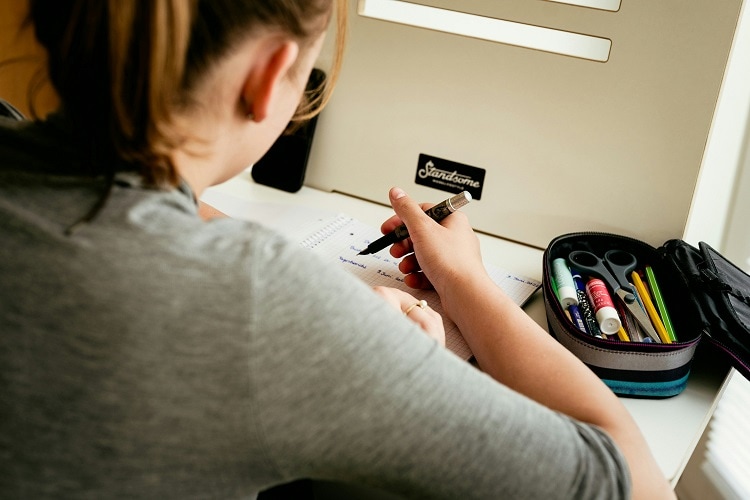
Home » Articles » How to Write a Great Essay (Tips for Kids)
How to Write a Great Essay (Tips for Kids)
Writing a great essay can be fun and easy if kids follow some simple tips like brainstorming ideas, creating an outline, and writing clear and concise sentences. Academized services can be incredibly helpful for young writers, providing guidance and examples to ensure they understand the basics of essay writing. With the support of Academized.com essay writing service, kids can learn to organize their thoughts and present them effectively, making the writing process less daunting and more enjoyable.
With the right guidance and practice, anyone can become a skilled essay writer. In this post, we’ll explore some valuable tips to help kids write great essays.
The Essay Structure
Before you start writing, it’s essential to understand the basic structure of an essay. A well-structured essay consists of three main parts: the introduction, the body, and the conclusion.
1. The Introduction
The introduction is where you capture the reader’s attention and provide an overview of your essay’s main idea or thesis statement. It should be concise and engaging, leaving the reader eager to learn more.
2. The Body
The body is the meat of your essay, where you present your arguments, evidence, and supporting details. Each paragraph should focus on a single idea or point, supporting your thesis statement.
3. The Conclusion
The conclusion is your final opportunity to reinforce your main idea and leave a lasting impression on the reader. It should summarize your key points and provide a sense of closure.
Prewriting: Brainstorming and Planning
An Academized overview can show kids how professional writing services can assist in honing their essay-writing skills through expert tips and examples. Before you start writing, take some time to brainstorm and plan your essay. This step is crucial as it helps organize your thoughts and ideas, making the writing process smoother.
1. Brainstorming
Jot down any thoughts, ideas, or examples that come to mind related to your essay topic. Don’t worry about organizing them yet; just let your ideas flow freely.
2. Creating an Outline
Once you’ve brainstormed, organize your ideas into a logical outline. This will serve as a roadmap for your essay, ensuring that your thoughts are structured and coherent.
Creating an Engaging Introduction
The introduction is the first impression your reader will have of your essay, so it’s essential to make it captivating. Here are some tips for writing an engaging introduction:
1. Use a Hook
Start with an attention-grabbing statement, such as a quote, a rhetorical question, or an interesting fact related to your topic. This will pique the reader’s interest and encourage them to keep reading.
2. Provide Background Information
Give your reader some context by providing relevant background information about your topic. This will help them understand the importance and significance of your essay.
3. State Your Thesis
Clearly state your thesis statement, which is the main idea or argument of your essay. This will guide the reader through the rest of your essay and ensure that your writing stays focused.
Developing a Strong Body
The body of your essay is where you present your arguments, evidence, and supporting details. Here are some tips for developing a strong body:
1. Use Topic Sentences
Begin each body paragraph with a clear topic sentence that introduces the main idea or argument of that paragraph. This will help your reader follow your train of thought.
2. Provide Evidence and Examples
Support your arguments with relevant evidence, facts, examples, or quotes from reliable sources. This will strengthen your essay and make it more persuasive.
3. Analyze and Explain
Don’t just present information; analyze and explain it. Show your reader how the evidence supports your argument and why it’s important.
4. Transition Smoothly
Use transition words and phrases to guide your reader from one idea to the next, creating a smooth and logical flow throughout your essay.
Writing a Great Conclusion
The conclusion is your final opportunity to leave a lasting impression on your reader. Here are some tips for writing a compelling conclusion:
1. Restate Your Thesis
Briefly restate your thesis statement, but in different words than you used in the introduction. This will remind the reader of your main argument.
2. Summarize Key Points
Summarize the main points or arguments you’ve made throughout your essay. This will reinforce your ideas and leave a strong impression on the reader.
3. End with a Memorable Closing Statement
Conclude your essay with a memorable closing statement, such as a thought-provoking question, a call to action, or a powerful quote. This will leave the reader with something to ponder long after they’ve finished reading.
Revising and Editing
Once you’ve written your first draft, it’s time to revise and edit your essay. This step is crucial for improving the quality and clarity of your writing.
1. Read Your Essay Aloud
Reading your essay aloud can help you identify areas that need improvement, such as awkward phrasing, poor flow, or unclear explanations.
2. Check for Clarity and Coherence
Ensure that your ideas are clearly expressed and that your essay flows logically from one point to the next. If something is unclear or confusing, revise it.
3. Proofread for Errors
Carefully proofread your essay for spelling, grammar, and punctuation errors. These small mistakes can detract from the overall quality of your writing.
4. Get Feedback
Ask a trusted friend, family member, or teacher to read your essay and provide feedback. Fresh eyes can often spot areas for improvement that you may have missed.
Statistics and Facts
To support the importance of writing essays and the need for guidance, here’s a table with relevant statistics:
| Only 27% of students in the US are proficient in writing at or above grade level. | National Assessment of Educational Progress (NAEP), 2022 |
| 76% of teachers believe that writing instruction in schools should be prioritized more. | National Writing Project, 2021 |
| Students who receive explicit writing instruction perform better on standardized tests and have higher overall academic achievement. | Graham & Perin, 2007 |
| Writing skills are essential for success in college and the workplace, yet many students struggle with writing. | National Council of Teachers of English, 2019 |
| Providing feedback and opportunities for revision can improve student writing by up to 26%. | Education Endowment Foundation, 2017 |
By following these tips and incorporating relevant statistics and facts, kids can develop the skills needed to write great essays. Remember, writing is a process that takes practice, but with dedication and guidance, anyone can become a skilled essay writer.
Related Posts:

Leave a Reply Cancel reply
Your email address will not be published. Required fields are marked *
Save my name, email, and website in this browser for the next time I comment.
- Skip to content
- Skip to search
- Staff portal (Inside the department)
- Student portal
- Key links for students
Other users
- Forgot password
Notifications
{{item.title}}, my essentials, ask for help, contact edconnect, directory a to z, how to guides, going to school, writing essays.
Writing essays can be straightforward when you have a clear essay plan.
Students are introduced to composing more complex and extended texts as they progress through their schooling.
- In Stage 2 (Years 3 and 4), students write longer texts with multiple paragraphs.
- From Stage 3 (Years 5 and 6), students are writing complex, longer texts.
- In high school, students write extended responses or essays in most subjects.
The following general advice will be helpful to read through with your child – Year 5 and above.
Teachers of individual subjects and year levels will have more specific information related to individual tasks.
Essay structure
An essay is an extended answer to a set question. Most extended responses follow the same structure of 3 main parts: introduction, body and conclusion. All essays should be thoroughly planned before starting writing.
1. Introduction
The first paragraph answers the question and outlines the ideas to be presented in the essay. It makes a first impression on the reader – the reader now knows what to expect. Do not just rewrite the question; it is important to give a point of view.
The body of an essay should be at least 4 to 6 paragraphs in length. Each paragraph introduces one major idea. Each idea should be fully explained and supported by evidence such as statistics, examples, quotes from a text or authority, or an explanation of events. If an idea is particularly complicated it may require more than one paragraph.
Never cram lots of different ideas into one paragraph. On the other hand, if all paragraphs are very short, the extended response will be a series of disjointed points rather than a coherent, logical argument.
The basic structure of each paragraph is:
- topic sentence (a generalisation to introduce the paragraph’s purpose) – this will normally be the first sentence
- explanation and elaboration of your point
- examples, quotations or evidence
- final concluding sentence which links with the paragraph that follows.
A good way to remember the structure is TEEL – Topic sentence, Explanation, Examples and Link.
3. Conclusion
A conclusion shouldn’t only restate the question or repeat the introduction. Don’t start with ‘In conclusion, to sum up etc.’ A conclusion should be a summary of the various points of your argument. Don’t throw in new information – that shows a lack of planning.
Writing an essay
The most important thing to do when writing an essay is to answer the question asked. Questions never require students to ‘tell us everything you know about the topic’ so it is important to carefully read the question asked. The best students circle or highlight the main words in the question so they stay focused on what they are writing about.
Extended responses usually have a key word which directs the structure such as, ‘explain’, ‘describe’, ‘analyse’ and so on. This helps students understand the structure their essay should take.
Writing essays at home, in class, or during an exam requires the same steps – the time taken will be different.
- The most important step is planning – work out what the question is asking. Circle or highlight the important words – including the key words that tell you how to approach your answer.
- Brainstorm facts, examples, evidence and so on relevant to the question – remember your focus is to answer the question asked – no question is going to ask you to write everything you know about a topic.
- Sort your brainstorm into a logical order – link ideas that go together – an essay needs to flow logically.
- Once there is a clear and logical plan to follow, start writing. It is important to stay on message – use topic sentences which focus on answering the question asked. Remember, one idea equals one paragraph.
- Provide elaboration, evidence, explanation, examples, evaluation or analysis as required by the question.
- Ensure the essay flows logically. Linking sentences can be used to connect ideas in paragraphs.
- Read over the response carefully to make sure the answer to the question is clear, that there is evidence and/or examples to support the answer. Read as a reader, not as a writer. If the task is done at home, having a fresh set of eyes such as a parent or sibling read the essay will highlight possible issues as it’s easy to miss mistakes in your own writing, as you know what you meant.
- Regardless of the subject, using formal English is important when writing a formal essay. Use clear, logical paragraphs, full sentences, correct spelling and punctuation and an effective vocabulary – no slang or writing like you speak.
Use the following checklist when reading through an essay.
- answers the question asked
- uses paragraphs to logically structure ideas – each focuses on the question asked
- has an introduction which outlines reasons for the answer to the question
- has a body made up of several paragraphs – each paragraph elaborates on a point
- uses topic sentences in paragraphs
- uses effective language so your point of view is clear
- has a conclusion which reiterates the main points but does not include any new information
- does not re-tell the story
- contains no colloquial language or slang
- has correct spelling and punctuation
- adheres to the word limit.
Under exam conditions, there is limited time for students to write their essays – generally about 40 minutes. Impress upon them the importance of planning and checking, even when writing a response under exam conditions.
- Community engagement
- Student assessment
- Writing skills
Business Unit:
- Communication and Engagement
Essay Writing

Essays are pieces of writing that are longer than just a paragraph but not quite as long as a full-length book. Essay writing is an excellent way for students to demonstrate their understanding of various topics. Essays are typically assigned when a teacher wants students to think critically about the scope of the class or when they want to assess how much information was retained during class. Teachers can give essay-writing assignments or conduct competitions at any time during the academic year.
To learn how to write an essay, click on essay writing topics for children .
Essays are generally used in schools where students are expected to gather information from multiple sources and synthesise it into one written piece of work.
Essay writing in English is often a part of the curriculum for students attending primary or high school classes. This skill can be learned through practice with early writing assignments. There are broadly four types of essays: narrative essays, descriptive essays, expository essays and persuasive essays.
Importance of Essay Writing
Essay writing is an integral part of the curriculum. They are used to assess our knowledge and evaluate our understanding based on our study of certain subjects.
Essay writing is a skill that everyone should learn. It will help in many aspects of life, from school to interviews and other real-life situations. There are a lot of services available online that can help with this challenging task. If students are unsure how to write an essay, use a free essay writing service to provide tips and tricks for writing a good one.
Essays are an essential part of any modern education, and they are also handy for professional purposes. They help students learn how to organise their thoughts, communicate effectively, and develop research skills, among others.
If you’re not sure where to start with essay writing, take a look at this article. For more essay topics for kids, visit BYJU’S website.
Frequently Asked Questions on Essay Writing
Why is essay writing an integral part of the curriculum.
Essay writing is an integral part of the curriculum because it is a skill that everyone should learn. It helps students learn how to organise their thoughts, communicate effectively, develop research skills, etc. It will also help in many aspects of life, such as interviews and other real-life situations.
What is an essay?
Essays are pieces of writing that are longer than just a paragraph but not quite as long as a full-length book. Essay writing is an excellent way for students to demonstrate their understanding of the course material.
Leave a Comment Cancel reply
Your Mobile number and Email id will not be published. Required fields are marked *
Request OTP on Voice Call
Post My Comment
Register with BYJU'S & Download Free PDFs
Register with byju's & watch live videos.
Have a language expert improve your writing
Run a free plagiarism check in 10 minutes, generate accurate citations for free.
- Knowledge Base
The Beginner's Guide to Writing an Essay | Steps & Examples
An academic essay is a focused piece of writing that develops an idea or argument using evidence, analysis, and interpretation.
There are many types of essays you might write as a student. The content and length of an essay depends on your level, subject of study, and course requirements. However, most essays at university level are argumentative — they aim to persuade the reader of a particular position or perspective on a topic.
The essay writing process consists of three main stages:
- Preparation: Decide on your topic, do your research, and create an essay outline.
- Writing : Set out your argument in the introduction, develop it with evidence in the main body, and wrap it up with a conclusion.
- Revision: Check your essay on the content, organization, grammar, spelling, and formatting of your essay.
Instantly correct all language mistakes in your text
Upload your document to correct all your mistakes in minutes

Table of contents
Essay writing process, preparation for writing an essay, writing the introduction, writing the main body, writing the conclusion, essay checklist, lecture slides, frequently asked questions about writing an essay.
The writing process of preparation, writing, and revisions applies to every essay or paper, but the time and effort spent on each stage depends on the type of essay .
For example, if you’ve been assigned a five-paragraph expository essay for a high school class, you’ll probably spend the most time on the writing stage; for a college-level argumentative essay , on the other hand, you’ll need to spend more time researching your topic and developing an original argument before you start writing.
| 1. Preparation | 2. Writing | 3. Revision |
|---|---|---|
| , organized into Write the | or use a for language errors |
Prevent plagiarism. Run a free check.
Before you start writing, you should make sure you have a clear idea of what you want to say and how you’re going to say it. There are a few key steps you can follow to make sure you’re prepared:
- Understand your assignment: What is the goal of this essay? What is the length and deadline of the assignment? Is there anything you need to clarify with your teacher or professor?
- Define a topic: If you’re allowed to choose your own topic , try to pick something that you already know a bit about and that will hold your interest.
- Do your research: Read primary and secondary sources and take notes to help you work out your position and angle on the topic. You’ll use these as evidence for your points.
- Come up with a thesis: The thesis is the central point or argument that you want to make. A clear thesis is essential for a focused essay—you should keep referring back to it as you write.
- Create an outline: Map out the rough structure of your essay in an outline . This makes it easier to start writing and keeps you on track as you go.
Once you’ve got a clear idea of what you want to discuss, in what order, and what evidence you’ll use, you’re ready to start writing.
The introduction sets the tone for your essay. It should grab the reader’s interest and inform them of what to expect. The introduction generally comprises 10–20% of the text.
1. Hook your reader
The first sentence of the introduction should pique your reader’s interest and curiosity. This sentence is sometimes called the hook. It might be an intriguing question, a surprising fact, or a bold statement emphasizing the relevance of the topic.
Let’s say we’re writing an essay about the development of Braille (the raised-dot reading and writing system used by visually impaired people). Our hook can make a strong statement about the topic:
The invention of Braille was a major turning point in the history of disability.
2. Provide background on your topic
Next, it’s important to give context that will help your reader understand your argument. This might involve providing background information, giving an overview of important academic work or debates on the topic, and explaining difficult terms. Don’t provide too much detail in the introduction—you can elaborate in the body of your essay.
3. Present the thesis statement
Next, you should formulate your thesis statement— the central argument you’re going to make. The thesis statement provides focus and signals your position on the topic. It is usually one or two sentences long. The thesis statement for our essay on Braille could look like this:
As the first writing system designed for blind people’s needs, Braille was a groundbreaking new accessibility tool. It not only provided practical benefits, but also helped change the cultural status of blindness.
4. Map the structure
In longer essays, you can end the introduction by briefly describing what will be covered in each part of the essay. This guides the reader through your structure and gives a preview of how your argument will develop.
The invention of Braille marked a major turning point in the history of disability. The writing system of raised dots used by blind and visually impaired people was developed by Louis Braille in nineteenth-century France. In a society that did not value disabled people in general, blindness was particularly stigmatized, and lack of access to reading and writing was a significant barrier to social participation. The idea of tactile reading was not entirely new, but existing methods based on sighted systems were difficult to learn and use. As the first writing system designed for blind people’s needs, Braille was a groundbreaking new accessibility tool. It not only provided practical benefits, but also helped change the cultural status of blindness. This essay begins by discussing the situation of blind people in nineteenth-century Europe. It then describes the invention of Braille and the gradual process of its acceptance within blind education. Subsequently, it explores the wide-ranging effects of this invention on blind people’s social and cultural lives.
Write your essay introduction
The body of your essay is where you make arguments supporting your thesis, provide evidence, and develop your ideas. Its purpose is to present, interpret, and analyze the information and sources you have gathered to support your argument.
Length of the body text
The length of the body depends on the type of essay. On average, the body comprises 60–80% of your essay. For a high school essay, this could be just three paragraphs, but for a graduate school essay of 6,000 words, the body could take up 8–10 pages.
Paragraph structure
To give your essay a clear structure , it is important to organize it into paragraphs . Each paragraph should be centered around one main point or idea.
That idea is introduced in a topic sentence . The topic sentence should generally lead on from the previous paragraph and introduce the point to be made in this paragraph. Transition words can be used to create clear connections between sentences.
After the topic sentence, present evidence such as data, examples, or quotes from relevant sources. Be sure to interpret and explain the evidence, and show how it helps develop your overall argument.
Lack of access to reading and writing put blind people at a serious disadvantage in nineteenth-century society. Text was one of the primary methods through which people engaged with culture, communicated with others, and accessed information; without a well-developed reading system that did not rely on sight, blind people were excluded from social participation (Weygand, 2009). While disabled people in general suffered from discrimination, blindness was widely viewed as the worst disability, and it was commonly believed that blind people were incapable of pursuing a profession or improving themselves through culture (Weygand, 2009). This demonstrates the importance of reading and writing to social status at the time: without access to text, it was considered impossible to fully participate in society. Blind people were excluded from the sighted world, but also entirely dependent on sighted people for information and education.
See the full essay example
The conclusion is the final paragraph of an essay. It should generally take up no more than 10–15% of the text . A strong essay conclusion :
- Returns to your thesis
- Ties together your main points
- Shows why your argument matters
A great conclusion should finish with a memorable or impactful sentence that leaves the reader with a strong final impression.
What not to include in a conclusion
To make your essay’s conclusion as strong as possible, there are a few things you should avoid. The most common mistakes are:
- Including new arguments or evidence
- Undermining your arguments (e.g. “This is just one approach of many”)
- Using concluding phrases like “To sum up…” or “In conclusion…”
Braille paved the way for dramatic cultural changes in the way blind people were treated and the opportunities available to them. Louis Braille’s innovation was to reimagine existing reading systems from a blind perspective, and the success of this invention required sighted teachers to adapt to their students’ reality instead of the other way around. In this sense, Braille helped drive broader social changes in the status of blindness. New accessibility tools provide practical advantages to those who need them, but they can also change the perspectives and attitudes of those who do not.
Write your essay conclusion
Checklist: Essay
My essay follows the requirements of the assignment (topic and length ).
My introduction sparks the reader’s interest and provides any necessary background information on the topic.
My introduction contains a thesis statement that states the focus and position of the essay.
I use paragraphs to structure the essay.
I use topic sentences to introduce each paragraph.
Each paragraph has a single focus and a clear connection to the thesis statement.
I make clear transitions between paragraphs and ideas.
My conclusion doesn’t just repeat my points, but draws connections between arguments.
I don’t introduce new arguments or evidence in the conclusion.
I have given an in-text citation for every quote or piece of information I got from another source.
I have included a reference page at the end of my essay, listing full details of all my sources.
My citations and references are correctly formatted according to the required citation style .
My essay has an interesting and informative title.
I have followed all formatting guidelines (e.g. font, page numbers, line spacing).
Your essay meets all the most important requirements. Our editors can give it a final check to help you submit with confidence.
Open Google Slides Download PowerPoint
An essay is a focused piece of writing that explains, argues, describes, or narrates.
In high school, you may have to write many different types of essays to develop your writing skills.
Academic essays at college level are usually argumentative : you develop a clear thesis about your topic and make a case for your position using evidence, analysis and interpretation.
The structure of an essay is divided into an introduction that presents your topic and thesis statement , a body containing your in-depth analysis and arguments, and a conclusion wrapping up your ideas.
The structure of the body is flexible, but you should always spend some time thinking about how you can organize your essay to best serve your ideas.
Your essay introduction should include three main things, in this order:
- An opening hook to catch the reader’s attention.
- Relevant background information that the reader needs to know.
- A thesis statement that presents your main point or argument.
The length of each part depends on the length and complexity of your essay .
A thesis statement is a sentence that sums up the central point of your paper or essay . Everything else you write should relate to this key idea.
The thesis statement is essential in any academic essay or research paper for two main reasons:
- It gives your writing direction and focus.
- It gives the reader a concise summary of your main point.
Without a clear thesis statement, an essay can end up rambling and unfocused, leaving your reader unsure of exactly what you want to say.
A topic sentence is a sentence that expresses the main point of a paragraph . Everything else in the paragraph should relate to the topic sentence.
At college level, you must properly cite your sources in all essays , research papers , and other academic texts (except exams and in-class exercises).
Add a citation whenever you quote , paraphrase , or summarize information or ideas from a source. You should also give full source details in a bibliography or reference list at the end of your text.
The exact format of your citations depends on which citation style you are instructed to use. The most common styles are APA , MLA , and Chicago .
Is this article helpful?
Other students also liked.
- How long is an essay? Guidelines for different types of essay
- How to write an essay introduction | 4 steps & examples
- How to conclude an essay | Interactive example
More interesting articles
- Checklist for academic essays | Is your essay ready to submit?
- Comparing and contrasting in an essay | Tips & examples
- Example of a great essay | Explanations, tips & tricks
- Generate topic ideas for an essay or paper | Tips & techniques
- How to revise an essay in 3 simple steps
- How to structure an essay: Templates and tips
- How to write a descriptive essay | Example & tips
- How to write a literary analysis essay | A step-by-step guide
- How to write a narrative essay | Example & tips
- How to write a rhetorical analysis | Key concepts & examples
- How to Write a Thesis Statement | 4 Steps & Examples
- How to write an argumentative essay | Examples & tips
- How to write an essay outline | Guidelines & examples
- How to write an expository essay
- How to write the body of an essay | Drafting & redrafting
- Kinds of argumentative academic essays and their purposes
- Organizational tips for academic essays
- The four main types of essay | Quick guide with examples
- Transition sentences | Tips & examples for clear writing
"I thought AI Proofreading was useless but.."
I've been using Scribbr for years now and I know it's a service that won't disappoint. It does a good job spotting mistakes”
How to Write an Essay for Primary School: Topics, Structure, Tips, Examples
Publication Date: 17 December 2022
Ask any primary school student, “What is the most difficult thing at school?” Most likely, they will shrug their shoulders and will not be able to formulate a clear answer.
At the same time, a primary school teacher would answer: “Well, many things actually, which pertain to how to create an essay for primary school: children don’t know how to think about an essay topic, how to start, and how to finish the text, they don’t know how to draw up a plan and don’t understand why it is needed, they can’t formulate coherent thoughts, and build the logic of presentation.”
In our opinion, this is largely due to the fact that primary school children are not explained in due time, even in elementary school, simple things, the basics of how to write an essay for primary school.

How to Write an Essay for Primary School – Acknowledge the Simple Things
- An essay is a presentation of a certain order of one’s thoughts on a certain topic. Writing an essay in many ways resembles talking with one’s friends: when you need to formulate a clear thought, explain something, tell a story or a joke, etc.
- Writing an essay for primary school is not a test, but just a special training exercise, with the help of which a person develops their coherent written speech and at the same time learns to write correctly (even with speaking, one needs to practice it regularly, just like in sports or dancing).
- Writing as a type of speech activity is very closely related to reading: a literate reader who can read and distinguish all levels of information from a text writes better, as he understands these levels of information in texts.
- Any essay will have readers, and the author needs to convey to them his (or her) thoughts, emotions, and his (her) attitude to what he (or she) is talking about, and to correctly and clearly state all the above. A competent text speaks of the author’s general culture and respect for the reader. In this battle for the result, we, unfortunately, are still losing. But it is the task of adults to help the child learn to speak and write beautifully and correctly in their native language.
How to Write an Essay for Primary School – The To-Do List
The first step is to read carefully and understand (discuss with your parents, friends, and class) the above simple things. Perhaps, you will end up modifying something, adding your own points that will help you write your first essay for primary school.
The second is to clearly articulate what you need to do to learn how to write essays. There are several critical skills:
- Analyze the topic, and highlight keywords in it. There may be a prompt instead of a topic. Prompts are usually made up of several related sentences. There might also be a question in your prompt, which you will have to answer.
- Formulate the main idea (thought) of your essay. In an essay for primary school, students learn to include a thesis statement – a key point that the author has to prove/explain/describe. A thesis statement is always placed in the introductory part and is typically one sentence long.
- Draw up a plan for the future text, based on the type of essay. In learning how to write an essay for primary school, it is enough to understand that before the actual writing, there must be a planning step – either draw a rough sketch of your work on a piece of paper or think it through in your head.
- Write an introduction that matches the topic and includes your main idea (thesis statement).
- Write the main part and conclusion according to the plan. The main part always focuses on explaining or proving your main idea formulated earlier (in the introduction). At the same time, it is not always necessary to plan the conclusion beforehand. In an essay for primary school, a conclusion may consist of a couple of sentences only.
- Check the text, and find and correct errors (in content, format, grammar, spelling, or punctuation). At this stage, it is important to learn how to use online editing and grammar tools – this skill will always be useful in college or university.
- Evaluate the quality of the written text. It helps to take a small break from writing and come back with a fresh mind. If necessary, make changes and reread your final text one final time.

Each of these skills needs to be developed both separately and in combination with others, starting from the middle years in primary school, when students get acquainted with simple and complex sentences, with homogeneous sentence members and punctuation in these constructions. And before that, it is very important to regularly engage in the oral retelling of various texts, writing free dictations and making short presentations, as well as crafting long-forgotten letters and postcards to relatives and friends.
Knowing how to write an essay for primary school is not the main goal: the ability to write correctly can always come in handy after school in writing emails, social media posts, publishing reviews, composing resumes, letters of motivation, etc. And for this, you need to learn what an essay for primary school is, what it is made of, how to formulate each part correctly, and how to express yourself through texts in general.
Frequently Asked Questions
How long should an essay for primary school be?
There are no strict requirements for the length of primary school essays. In general, these are simple and short essays, up to 200-300 words.
How shall I finish my essay for primary school?
The conclusion of a primary school essay should reiterate the main idea in a couple of simple sentences. When learning how to write an essay for primary school, practice conclusive phrases and sentences whenever possible.
Can I choose my own theme to write about?
If a teacher gave you a fixed topic, which you don’t like or don’t understand, we strongly recommend you go and talk with your teacher about your difficulties and ask if you can modify the given topic or come up with another interesting one.
Can I include drawings and pictures in my essay?
Yes, of course, though we recommend keeping those at a minimum level unless the type of your essay stipulates visual content (e.g. a photo essay).
Related Blog Posts
You have been asked to write a memoir essay in your class and don’t know what topic to choose, how to do it...
Publication Date: 15 September 2022
It’s fair to say that a summary is the bread and butter of a student’s life. While in college, we learn to write...
Publication Date: 05 September 2022
Best essay writing services based on reviews

99Papers.com Review

EssayBox.org Review

BookwormLab.com Review

EssayFactory.uk Review
Your Overal Rating
Service name
The quality of our reviews and ratings depends greately on the input from the actual services users. Please help us improve our work with your feedback!
Thank you for submitting your review, we do value your input!

Key Tips On Writing Good Compositions For Primary School
- Primary School Composition Writing

6 Tips On How to Write a Good Composition For Primary School Students
Picture this: your child sits down to write and their ideas effortlessly flow onto the page, characters and plots coming alive right before their eyes. They’re so immersed in writing their story that the world around them seems to fade away!
Isn’t this the writing experience you want for your child?
How do we make this a reality? You’ve likely offered your child the usual advice: “Read more books”, “Write more compositions”, or “Use better phrases”.
But let’s face it—these suggestions are too vague to be truly helpful. It’s time to move beyond generalities and work smarter, not harder. We will give you six proven tips for primary school students that offer concrete techniques to elevate their composition writing. First, let us understand more about composition writing.
Primary School Compositions
Composition writing is tested in Paper 1 of the English language paper. It requires students to write a narrative essay based on a given theme and at least one of three picture prompts. The length of the essay is 150 words for P5 and P6 students (and lower for P1 to P4 students).
Students are assessed on two components: Content and Language. To score well for the former, students need to demonstrate creative, logical and relevant ideas that align with the topic. Language, on the other hand, focuses on more technical aspects such as grammar, punctuation and spelling. A well-written composition will present clear and coherent ideas expressed in an appropriately creative manner.
But before you read this post… you might want to download this ebook first.
More than 18,725 parents have downloaded this ebook for their children. A compilation of some of the best compositions from our students.
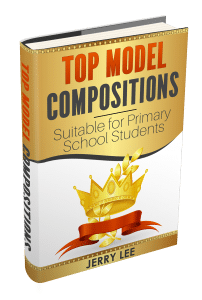
- Common Test / Exam Compo Topics
- Strong Intros
- Descriptive Scenes
- Impactful Endings
- Powerful Vocabulary
1. Study the theme
Most picture compositions are composed of:
- Introduction
- Conflict / Problem
These four connect with one another to create a singular theme. It gives direction and purpose to the story to make it easy and enjoyable. When bringing out the central idea, it’s important to identify the keywords. For this, advise your child to look at the title.
Determine the Type of Composition
When it comes to the title, there can be three types of compositions :
- Positive (e.g. A Memorable Event, An Achievement)
- Negative (e.g. A Disappointment, A Bad Decision)
- Neutral (e.g. A Competition, A Promise)
Get your child to read the theme carefully and identify the keywords. They could help your child figure out the type of composition they have to write.
A) Positive Composition Type
Positive composition types refer to – as the name suggests – a happy or an uplifting theme. Topics that fall under this umbrella include “A Celebration”, “A Success” and “A Pleasant Surprise” to name a few. Writing these type of composition can seem deceptively easy at first. However, the challenge lies in successfully incorporating a problem element in the story while staying true to the theme.
B) Negative Composition Type
Negative composition types include topics such as ‘Making a Mistake’, ‘Something That Was Damaged’, ‘A Disagreement’ and ‘Being Anxious’. Such compositions feature unfavourable circumstances and detail how the protagonist navigates these challenges. The overemphasis on negative composition types in the past means that students may struggle to come up with fresh takes and instead, stick to overused plot ideas.
C) Neutral Composition Type
Finally, the neutral composition type arguably provides the most room for creativity and nuance. This category encompasses prompts like “Something Unexpected”, “A Long Wait”, “Being Curious” and “An Adventure”. Although this allows for students to come up with novel ideas, care must be taken not to write out of topic.
Encourage them to categorise their compo question as well. This can help because sometimes, children may make the mistake of writing an accident as “A Memorable Event”.

Yeah, no injury is worth remembering, since you probably won’t consider an incident that got you hurt as special.
2. Analyse/choose the pictures for your composition
A very common mistake is that children follow the topic… but they forgot to use any of the three pictures! This can prove fatal to their final marks because if none of the pictures are used, it’s an automatic fail in Content, which comprises half the marks in the picture composition.
There are many possible plots just from one theme. However, always ensure that your child chooses at least one of the pictures and incorporates it into the story. Make sure there is some focus of the object in the story. Otherwise, your child probably won’t score very high in Content.
Of course, your child might have trouble deciding what picture to use. To help your child’s decision, let’s take a look at last year’s PSLE’s Picture Composition as an example.

One thing your child should consider is their current vocab. Ask them, “If you were to select this picture, do you have the necessary words and phrases to effectively describe it?”
For example, some may find it easier to use the first picture and use it as the primary focus of their story, because they might know a variety of words for anger (e.g. furious, livid). Your child should keep this in mind when choosing the picture since it gives them a writing advantage.
Whether you are writing a picture composition for primary 3,4,5 or 6…You may ask, “Should my child always avoid a picture because they don’t have the vocabulary/good phrases for it?”
The answer is: No.
What this means is your child should take this chance to expand their vocabulary, so that they could write for a broader range of topics. Moreover, you never know when the pictures might come up again, albeit for a different theme.
3. Plan the Composition

Ever heard of, “If you fail to plan, you plan to fail?” Your child should always plan for their picture compositions. While there is nothing wrong with writing on the fly, it is risky for less experienced writers. They may come face to face with the following problems:
- Sudden transitions: What happened between two sentences remain a mystery. (e.g. I chased the thief. I caught him)
- Change of pronouns: This happens when students decide to write from a third-person perspective and then switch to a first-person halfway, or vice-versa.
- Writing a meaningless introduction: If the composition is about A Bad Decision, your child should not describe trivial things like the weather.
- Lack of closure/weak ending: Your child may find themselves stuck in trying to solve the conflict they came up with or end the story.
Ask your child to pen down any ideas that come into their mind when they brainstorm for the topic.
Get them to lay out the following:
- The characters & the roles they play in the story
- The main problem
- The resolution.
Think of the story as climbing a hill, getting to the top, and coming down it. From there, your child should order the points like this:

Most importantly, make sure the essay is realistic!
Even though you and I wish it was possible, if someone got into a car accident, there is no way a doctor would just put plaster and send them home.
4. How to start the composition
Your child has planned their story, but now the blank page looms before them. Here’s the challenge: how to begin?
The introduction sets the tone, engages the reader and determines whether they’ll keep reading. It’s a chance to make a lasting first impression. Rather than relying on cliched openings like “Ring! Ring! The bell rang” or memorised “model” introductions, your child should aim to hook the reader from the very first sentence.
Let’s explore five effective ways to begin a story with impact.

A) Start with a Flashback
The flashback technique uses an object or event in the present to trigger a memory, transporting the reader to the past where your main story unfolds.
To craft an effective flashback introduction:
- Set the scene : Establish your main character’s current location and activity.
- Describe the trigger: Use your five senses to describe the object/ event that sparks the memory.
- Show the reaction: Convey your character’s feelings and thoughts towards the trigger.
- Transition to the past: Bridge the gap between present and past with a sentence
Check out this example of a flashback introduction:
The kitchen floor was a mess—utensils, pots and pans, and faded recipe books were scattered everywhere. Tommy sighed. His little sister had once again turned the kitchen into her personal playground! Tommy was cleaning up the mess when he noticed an old photograph peeking out from a stack of recipe cards. It was a picture of five-year-old him in a Superman cape standing proudly next to his grandmother, whose face was creased with laughter. Tommy’s heart skipped a beat, and a nostalgic feeling washed over him as he traced his fingers over his grandmother’s face. He took a deep breath, and for a moment, the smell of his grandmother’s apple pies seemed to fill the room, transporting him right back to her kitchen …
See how we incorporated the four steps to create the flashback intro? Do remind your child to “snap” back to the present in the conclusion to provide closure to the story.

B) Start with Dialogue
Starting a composition with dialogue is a simple way to immediately draw the reader into the scene. This technique is suitable for any topic and accessible to writers of all skill levels.
To use this technique effectively, your child should pay attention to not only the words spoken, but also the dialogue tags used. These tags are crucial—they reflect the emotion with which the words are spoken and, therefore, provide additional context.
For example, for the PSLE question “A Long Wait”, your child may start with a line like this:
“I’ve been waiting for ages!” Caleb grumbled, drumming his fingers on the sticky restaurant table. The buzz of the crowded restaurant only added to his frustration as he watched the waiter pass by yet again without a glance.
The dialogue tag “grumbled” clearly conveys the speaker’s frustration while the action drumming his fingers on the table suggests a sense of growing impatience.
However, not all dialogue openings are equally effective. Consider this weak example:
“We’re here!” I said as we arrived at the park.
Avoid vague or mundane statements that don’t add value to the story. Instead, try:
“I can’t believe we’re finally at Disneyland!” I squealed, my eyes widening at the sight of the iconic castle.
The stronger version clearly shows the character’s excitement, introduces the specific setting, and creates a vivid image in the reader’s mind.
As you can see, starting with dialogue is a great way to introduce your protagonist but that isn’t the only way…
C) Start with Character Thought
Character thoughts can be useful compo openers too.
Picture this: your character is in a situation where they can’t speak their mind. Maybe they’re in a quiet library, or perhaps expressing themselves would be just too risky. That’s where internal dialogue or thoughts come in; they have the same punch but with an extra dash of intimacy!
Let’s see this technique in action:
“This is it. After months of gruelling rehearsals, I’m finally here. I must not mess this up,” I told myself, plastering on a confident smile as I strode onto the stage.
In addition to setting the context, this opening captures the performer’s inner turmoil while showing their outward confidence . It is this contrast between the internal and external states that makes thought-based openings so powerful.
Let’s try another one:
If I don’t pass this exam, my parents will kill me, I thought as Mr. Lee returned the exam scripts.
This thought immediately establishes the high-stakes situation. It’s more effective than dialogue because it reveals a fear the character likely wouldn’t voice aloud in a classroom setting.
| : Did you notice the difference in punctuation between the two examples? You can structure thoughts with or without quotation marks. Both are fine. Also, try to vary your thought-indicating verbs. Instead of always using “thought”, try using verbs like “wondered” or “mused”, or simply integrate the thought seamlessly into the narrative. |

Vector 3d realistic illustration of open movie clapperboard or clapper isolated on background. Black cinema slate board, device used in filmmaking and video production. Film industry equipment
D) Start with Action
Lights, camera, action!
Start with Action means starting with a scene in the climax or nearing the climax of the story. This plunges the reader directly into excitement and action, which keeps them on the edge of their seats from. the very first sentence! This technique is particularly effective for compositions with a negative theme such as “An Accident” or “A Close Shave, which tend to be action-packed and fast-paced.
Let’s dive into an example:
The icy wind lashed at my face as I desperately clung to the edge of the cliff. “Hold on!” Jake shouted, straining to reach my outstretched hand. Below, the angry waves crashed against razor-sharp rocks. Is this my end? I wondered, panic rising as my grip weakened by the second.
Talk about a cliffhanger! Did you feel the excitement? Let’s break it down:
- Immediate conflict: From the very first sentence, we know the character is in danger, creating instant suspense. (Note that emotional confrontations can be equally tension-filled!)
- Powerful verbs: Words like “lashed” and “crashed” ramp up the danger.
- Curiosity hook: Why are they on a cliff? Who’s Jake? What happens next?
After your gripping opener, you can transition to earlier events to provide context:
It all started two hours ago when…
Execution is key when it comes to this technique; you need to balance excitement with clarity. After all, you want your readers intrigued, not confused!
E) Start with Vivid Description
While action-packed openings are great for high-intensity stories, sometimes a more nuanced approach is needed. Starting with a vivid description works for slower-paced narratives, character-driven or rely heavily on setting.
Let’s explore how to write vivid descriptions for both characters and settings .
- Character-based Intro
Consider a composition on “Being Responsible” that must feature a hardworking character. Instead of directly stating their qualities, it’s more engaging to show them through description.
Here’s an example of a character who begins as irresponsible:
Jia Min slouched in her chair, further rumpling her wrinkled uniform. Her half-open eyes struggled to focus on the whiteboard. When will this torture end? As the teacher’s voice droned on, a soft snore escaped her slightly parted lips. Her best friend’s sharp elbow jabbed her ribs, eyes darting meaningfully towards Jia Min’s blank worksheet. Jia Min stifled a yawn, picked up her untouched pen and promptly began doodling.
This description not only captures Jia Min’s current lack of responsibility but also sets the stage for potential growth and change.
How to execute this technique well? For character-based introductions, focus on:
- Appearance : Describe physical features relevant to the story’s theme (e.g., the wrinkled uniform suggests irresponsibility).
- Behaviour and actions : Show the character’s nature through what they do (e.g., sleeping in class, doodling instead of taking notes).
- Thoughts and feelings : Provide insight into the character’s mind (e.g., Jia Min’s referring to class as torture).
This introduction shows an irresponsible character without explicitly stating it. It intrigues the reader: How will such a character become responsible by the end? The contrast sets up an interesting character arc.
- Setting-based Intro
Using vivid descriptions of a setting in the introduction can be equally effective. Even “boring” settings like parks can come to life if done right.
Check out this example:
I inhaled deeply, savouring the earthy scent of rain that lingered from an earlier downpour. The roots of a gnarly, old tree broke through the cracked path and created a natural speed bump for me during my daily evening jog. Rustle! A squirrel hurriedly scampered to a nearby tree as a group of animated aunties power-walked past me. Just then, a cool gust of wind caressed my face. Invigorated, I decided to extend my usual jog by one more lap.
This vivid description of a routine jog in the park immediately draws us into the scene, don’t you think?
To write an effective setting-based introduction, your child should focus on:
- Five senses: Engage about 2 to 3 of the five senses (Can you identify which senses we used here?)
- Details. Details.: Pay attention to specific details which make the scene “real” and not just another cookie-cutter park scene.
- Character: How does the character interact with their environment? What are their feelings, actions, and thoughts?
Each of these techniques offers a unique way to start a composition. The key is to choose the method that best suits the story and theme. A strong opening gives a good first impression, so remind your child to spend some time on crafting the intro.
Now, let’s move on to the meat of the story, where the excitement truly begins.
5. Writing the Body
Hoo, boy. This will be a long ride, so fasten your seatbelts.
The most essential part of the compo is the body, because that is where most of the action is. When it comes to the body, there are three parts to consider:
A) Rising Action (Events before the conflict)
Most of the stories you and your child might have read would always include some problem that the protagonist has to face. Without it, there would be no story, and the plot can be dry. The same goes for any picture composition.
One of the mistakes students make is to state the problem right after the introduction. This runs the risk of an underdeveloped story, which can affect their Content marks. Your child needs to learn how to write the events preceding the main problem, then describe the conflict. This is better known as the rising action.
For example, your child can describe what the character(s) did or did not do that may have caused the problem they would face as the rising action.
It does not have to be long, but it must build up the story’s tension, which would lead to the climax.
B) Climax (The main problem)
This is where the peak of the story occurs, and the turning point happens. Your child should aim to show as much action and the characters’ emotions as possible. Depending on the topic, your child may need to write one of these types of conflict:
- Internal conflict: A moral dilemma (e.g. Your best friend stole a wallet. Should you tell the teacher, or keep it to yourself?)
- External conflict (Man-made) : (e.g. a bully)
- External conflict (Natural): (e.g. a fire)
C) Resolution (Falling action)
The third part of the composition’s body is the resolution, or how the main character solves the problem. This is better known as the falling action. Unfortunately, many students would rush through by writing one or two sentences due to lacking time or ideas. This comes at the cost of a sudden transition.
A thing to note is that most resolutions, primary school kids write would involve a figure of authority to solve the conflict for them. After all, in real life, most kids would turn to the adults, such as you or their teachers, to solve the problems.
If the story involves thieves, it would always have policemen included. In the case of a fire, no doubt there would be firemen. Rarely, the main character would solve the problem themselves.
It is true that some types of compositions(e.g. A Crime You Were Involved In) would leave them little choice but to involve the adults. If that happens, your child should describe the character’s attempts to do something about the problem before help arrives.
For a better resolution, your child should ask themselves two questions:
- What could the protagonist do to solve the conflict?
- How did he/she feel when they attempted to handle the problem?
6. Writing the conclusion
Once the resolution is done, remind your child to wrap up with an ending. That is where your child is supposed to tie up the loose ends and close the story. It is essential to give the readers an ending they are satisfied with, and not keep them in suspense.
What your child can write in the conclusion:
- Character’s reflections and thoughts about the story’s events
- Their feelings over what happened
- Their concluding actions or decisions of future actions.
Regardless, it’s advised for your child to always link the ending back to the theme or topic they are writing about.
It may sound like a lot to take in, but it’s possible for your child to learn how to write a good primary school composition. Writing is like any other skill; there are no shortcuts.
Once your child masters the six tips, all your child needs is time and practice. Remember, it’s not about the speed of their progress but their persistence and joy in the journey. If they just keep writing, every page will bring them one step closer to becoming a masterful storyteller.
See more related articles on Writing Samurai:
- Common PSLE Composition Topics – How to Handle Them?
- PSLE English Composition – Marking Scheme with Pictures!
- Example Model Compositions Primary School Students
- Picture Compositions for Primary School Students
“Help! My child can’t write! How can I improve my child’s writing skills?”
For a LIMITED TIME ONLY…
Download this FREE Ebook for your child. It contains 80 Awesome Phrases to describe emotions!
More than 11,437 students have benefited from this book!
Click or Tap on button below to download!
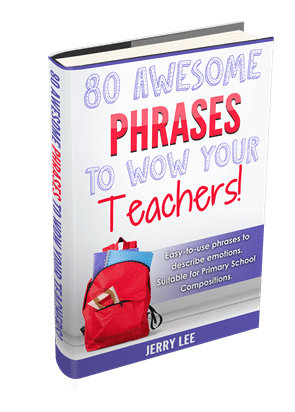
You can check out more Free Compo Writing Resources (Model Compos, Test Papers, etc) on this page >>> Free Compo Writing Resources

Follow Writing Samurai on Telegram for the latest tips and strategies for English, Chinese, and Creative Writing! Pssst... We will also share the latest compo topics during test or exam season!
Click this link to follow our channel >>> https://t.me/writingsamurai
Using Creative Words and Phrases for Composition Writing & Essays
50 idioms your child can use for composition writing.

Writing Samurai is an online platform dedicated to nurturing children’s creative writing skills. Our courses are designed to be engaging and effective, without resorting to traditional teaching methods.
Subscribe for latest news & English tips:
Terms of Use | Privacy Policy
2024 Copyright Writing Samurai
PRIMARY ENGLISH
- Model Compositions
- Situational Writing Tips
- PSLE English Oral Exam Tips
- PSLE Chinese Oral Exam Tips
- 50 Meaningful Proverbs
- Composition Writing
- PSLE Marking Scheme

SECONDARY ENGLISH
- Past Year's O-Level Essays
- Discursive Essay Writing
- Argumentative Essay Writing
- Secondary English Writing Tips (O-Levels)
- Exam Tips for Secondary English
- 7 Exam Tips for Language Editing (O-Levels)

POPULAR TOPICS
- English Oral
- Chinese Oral
- Situational Writing
- Secondary School Writing
- Essay Writing Lower Secondary
- Synthesis & Transformation
- Calculate AL PSLE Score
TOP FREE RESOURCES
- Free English Writing Resources List
- Free Model Compositions Examples
- Video - Proverbs Composition Writing
- Video - How to Write A Powerful Introduction
- Video - How to Use Good Expressions in your Compositions
- Free Online Writing Course - Kick Start Your Writing
TOP COURSES
- Junior Writers Masterclass - P1 / P2
- Little Writers Masterclass - P3 / P4
- Creative Writing Masterclass - P5 / P6
- Chinese Composition Writing - P5 / P6
- Essay Writing Masterclass - S1 / S2
- Essay Writing - Expository & Argumentative Crash Course
- Grammar Editing Crash Course for Secondary School
- Model Composition Examples
- Free Model Compositions
Writing Prompts for Elementary School Students
Tim Platt/Getty Images
- M.S., Education, Buffalo State College
- B.S., Education, Buffalo State College
Writing is an essential skill and an important part of elementary school studies. However, writing inspiration does not come easily to every student. Like adults, many children experience writer's block , particularly when an assignment is extremely open-ended.
Good writing prompts get students' creative juices flowing , help them write more freely, and ease any anxiety they may feel about the writing process. To integrate writing prompts into your lessons, ask students to choose one writing prompt each day or week. To make the activity more challenging, encourage them to write without stopping for at least five minutes, increasing the number of minutes that they devote to writing over time.
Remind your students that there is no wrong way to respond to the prompts and that they should simply have fun and let their creative minds wander. After all, just as athletes need to warm up their muscles, writers need to warm up their minds.
Elementary School Writing Prompts
- My biggest goal in life is...
- The best book I ever read was...
- The happiest moment in my life was when...
- When I grow up, I want to...
- The most interesting place I have ever been to was...
- Name three things you don't like about school and why.
- The strangest dream I ever had was...
- The person I admire most is...
- When I turn 16, I will...
- Who is the funniest member of your family and why?
- I get scared when...
- Five things I would do if I had more money are...
- What is your favorite sport and why?
- What would you do if you could change the world?
- Dear teacher, I would like to know...
- Dear President Washington, what was it like to be the first president?
- My happiest day was...
- My saddest day was...
- If I had three wishes, I would wish for...
- Describe your best friend, how you met, and why you are friends.
- Describe your favorite animal and why.
- Three things I like to do with my pet elephant are...
- The time a bat was in my house...
- When I become an adult, the first thing I want to do is...
- My best vacation was when I went to...
- The top three reasons that people argue are...
- Describe five reasons that going to school is important.
- What is your favorite television show and why?
- The time I found a dinosaur in my backyard...
- Describe the best present you ever received.
- Describe your most unusual talent.
- My most embarrassing moment was when...
- Describe your favorite food and why.
- Describe your least favorite food and why.
- The top three qualities of a best friend are...
- Write about what you would cook for an enemy.
- Use these words in a story: scared, angry, Sunday, bugs.
- What's your idea of a perfect vacation?
- Write about why someone might be afraid of snakes.
- List five rules that you have broken and why you broke them.
- What is your favorite video game and why?
- I wish someone had told me that...
- Describe the hottest day you can remember.
- Write about the best decision you've ever made.
- I opened the door, saw a clown, and then...
- The last time the power went out, I...
- Write about five things you can do if the power goes out.
- If I were president, I would...
- Create a poem using the words: l o ve, happy, smart, sunny.
- The time my teacher forgot to wear shoes...
- For prompts that ask students to write about a person, encourage them to write two responses—one response about a friend or family member, and another about someone they don't know personally. This exercise encourages children to think outside the box.
- Remind students that their responses can be fantastical. When the confines of realism are eliminated, students are free to think more creatively, which often inspires greater engagement in the project.
If you're looking for more writing ideas, try our lists of journal prompts or ideas for writing about important people in history like Martin Luther King Jr .
- 49 Opinion Writing Prompts for Students
- Writing Prompts for 7th Grade
- Writing a Lesson Plan: Closure and Context
- How to Write a Lesson Plan
- 3 Real World Exit Slips for Formative Assessment
- 8 First Day of High School Activities to Get to Know Your Students
- 5 Minute Activities for Elementary School Teachers
- Ice Breakers for the First Day of Elementary School
- The 12 Best Short Stories for Middle School Students
- Topics for a Lesson Plan Template
- Writing a Lesson Plan: Independent Practice
- The Best Interactive Debate Websites for Students and Teachers
- Holding Debates in Middle School Classes
- Short and Long Vowel Lesson Plan
- Writing a Lesson Plan: Guided Practice
- Lesson Plan Step #8 - Assessment and Follow-Up
- Primary Hub
- Art & Design
- Design & Technology
- Health & Wellbeing
- Secondary Hub
- Citizenship
- Primary CPD
- Secondary CPD
- Book Awards
- All Products
- Primary Products
- Secondary Products
- School Trips
- Trip Directory
- Trips by Subject
- Trips by Type
- Trips by Region
- Submit a Trip Venue
Trending stories

Top results

- How To Use Childrens Essays As Indicators Of Progress
How to use essay writing in primary school to measure curriculum impact

By using structure strips and comparative judgement, essay writing becomes a simple and effective end-of-topic assessment activity

- The link between essay writing and Ofsted’s ‘intention, implementation, impact’ agenda
- How pupils can use structure strips for essay writing
- How to use comparative judgement to mark essays
- What makes a good essay
Read in 3-5 minutes…
In 2019, Her Majesty’s Chief Inspector, Amanda Spielman, announced in a series of speeches that Ofsted would be shifting the focus of their inspections to the quality of education being offered in each school.
And with that flap of a butterfly’s wing, tornados raged across England’s schools, as senior leaders tore up curriculum plans and started again from scratch.
Ofsted suggested that curriculum can be understood through three lenses, which fortuitously, as is often the case in education, all begin with the same letter.
Intention, implementation and impact thus became top agenda items for every SLT meeting in the country.
In the first article of this series I suggested that this renewed focus isn’t really anything to worry about.
In fact, if handled with a level head, it should be an exciting and energising opportunity for teachers and leaders to carefully consider the torches that they will pass on to the next generation.
Exactly what knowledge being handed down is best described as the ‘intended’ curriculum, and we have explored knowledge organisers as a useful tool to set out these intentions.
The manner in which that knowledge is then sequenced – and how pupils interact with it – is perhaps less straightforward, but we have also explored using work booklets and quizzing as safe bets to support the ‘implemented’ curriculum.
What about the last ‘I’ in Ofsted’s triumvirate: ‘impact’?
There are a few different ways that we assess impact at Reach. We frequently have conversations with pupils about their learning. They should be able to speak confidently, authoritatively and with precision and enthusiasm about their topic.
Every half term we have a parent celebration event where they will present on what they’ve learned. We also use end-of-unit quizzes, giving us an overview of how much of the key knowledge has been retained over the term.
But perhaps the most transformational aspect of our foundation curriculum has been the introduction of essay writing.
At Reach, every child from Y2 upwards writes an essay at the end of each half term based on the topic that they are learning about.
In the younger years, the essay question will be relatively straightforward – for example, “How did the way people live change throughout the Stone Age?”
We give children a ‘ structure strip ’, with prompt questions for each section of the essay. The questions for each paragraph on the structure strip are linked to one of the six lessons in the work booklet.
So when writing the first paragraph, pupils will be prompted with, “How long ago was the Stone Age?” and, “What were the names of the different eras in the Stone Age.”
By answering these questions, pupils begin to construct a very impressive essay. It is also a chance to revisit, recall and play about with the knowledge, further embedding it in memory.
It’s true that to begin with, the essays are quite similar, but we are very comfortable with this.
After all, we’re not trying to trip them up, and writing essays is a new procedure for them. We want to give them lots of practice with a clear scaffold, so that by the time they get to year four or five, when we say “We’re writing an essay,” the class think, “Piece of cake, I’ll start with an overview of the topic’.
As pupils get older, the essays become more sophisticated. For example, after studying the civil rights movement in the US, our year sixes answer the question ‘“Civil disobedience was more important than legal decisions during the civil rights movement.” To what extent do you agree with this statement?’
This essay title forces pupils to apply their disciplinary skills as well as their substantive knowledge.
Due to the detailed work booklets we use for each unit, we know that all pupils are familiar with many incidences of civil disobedience: Rosa Parks refusing to stand on the bus; the Montgomery bus boycott; the Greensboro sit-in; the march from Selma to Montgomery.
However, they have also been taught about the legal aspects of civil rights: Jim Crow Laws; Brown vs the Board of Education; the doctrine of ‘separate but equal’; the Fourteenth Amendment; and the various Civil Rights Acts.
It is not enough, now, for our Y6s to simply restate what they have learned. Instead, we are asking them to make a judgement. Which was more important? What is the relationship between them?
In doing so, they are beginning to think like a historian thinks – exploring history as a discipline as well as a subject.
This, of course, is only possible with lots and lots of domain specific knowledge, which is why the detailed curriculum is so important.
To begin with, we found it difficult to assess the essays. After all, we hadn’t really considered what made a ‘good’ piece of history writing before.
Instead we were giving creative literacy tasks based loosely on some period (‘pretend to be a Victorian child and write a diary entry ’).
Now, though, we have a bank of essays for each unit of work that teachers can use before teaching a new topic to gain an idea of what can be expected.
We comparatively judge the essays of each unit, ranking them from best to worst. This gives a clear indication of an ‘expected standard’ essay, as well as ‘greater depth’ and working towards.
These essays are also useful indicators of progress, as year-on-year you can watch a child’s essays improve and become increasingly sophisticated.
In terms of professional development, looking at the differences both between high and low attaining essays, and also essays across years, can be extremely valuable.
It is fair to say (and was surprising to us) that all children love the essay writing. We often have difficulty ushering them to playtime during these lessons.
There seems to be something very satisfying about having a lot to write about and demonstrating that you have mastered a particular topic.
For many children, we also often get the best writing of the half term in these lessons.
So although some may baulk at the idea of essay writing in primary schools, I’d encourage you to give it a whirl at the end of your next topic.
It gives pupils a chance to apply their knowledge in a fulfilling way. It gives leaders a clear indication of how much pupils have learned in their topic. It gives you another great piece of writing for each child.
And it begins to show all pupils that each subject is a discipline, and that they can master, challenge and perhaps even add to the powerful knowledge within it.
What makes a good essay?
While analysing some recent essays together, teachers at our school noticed some common features of the best essays.
These top pupils organised their ideas in a very logical way. For example, they may have written, “There are several reasons that John is regarded as one of the worst kings in history”. Second, the best essays were balanced. So that same essay would list John’s shortcomings, before launching into an “However…” paragraph.
The best essays were also precise and detailed. They gave lots of examples to back up any points being made.
The importance of learning the facts included in the booklet can’t be stressed enough, then, as the pupils who have this automated found writing a doddle.
Jon Hutchinson is assistant headteacher at Reach Academy Feltham. Follow him on Twitter at @jon_hutchinson_ . Find all six articles in this series on taking a curriculum deep dive, here .
Sign up to our newsletter
You'll also receive regular updates from Teachwire with free lesson plans, great new teaching ideas, offers and more. (You can unsubscribe at any time.)
Which sectors are you interested in?
Early Years
Thank you for signing up to our emails!
You might also be interested in...

Why join Teachwire?
Get what you need to become a better teacher with unlimited access to exclusive free classroom resources and expert CPD downloads.
Exclusive classroom resource downloads
Free worksheets and lesson plans
CPD downloads, written by experts
Resource packs to supercharge your planning
Special web-only magazine editions
Educational podcasts & resources
Access to free literacy webinars
Newsletters and offers
Create free account
By signing up you agree to our terms and conditions and privacy policy .
Already have an account? Log in here
Thanks, you're almost there
To help us show you teaching resources, downloads and more you’ll love, complete your profile below.
Welcome to Teachwire!
Set up your account.
Lorem ipsum dolor sit amet consectetur adipisicing elit. Commodi nulla quos inventore beatae tenetur.
I would like to receive regular updates from Teachwire with free lesson plans, great new teaching ideas, offers and more. (You can unsubscribe at any time.)
Log in to Teachwire
Not registered with Teachwire? Sign up for free
Reset Password
Remembered your password? Login here


Complete Guide to the 10 Main Types of Essays for Students
Welcome to the wonderful world of essay writing! Throughout your academic journey, knowing how to express your thoughts, ideas and opinions through the medium of essay writing will be super important. Whether you’re dealing with an assignment for your English class or any other school subject, it’s crucial to understand the different types of essays and when to use them.

The 10 Main Essay Types Explained
1. narrative essays.
Purpose : Narrative essays weave stories, allowing writers to share personal experiences, lessons learned, or memorable moments, aiming to entertain or convey a particular message.
Usage : Often employed in personal statements for college or graduate school applications, where the goal is to provide a glimpse into the writer’s character.
Structure Example :
- Introduction : Captivate the reader’s attention with an engaging opening that hints at the central theme.
- Body : Chronicle the events in chronological order, utilising literary techniques such as metaphors, alliteration, and dialogue.
- Conclusion : Summarise the main point or highlight the significance of the narrative, reinforcing the central message.
2. Descriptive Essays
Purpose : To vividly depict a subject, be it a person, place, thing, or event, invoking sensory experiences and creating a vivid picture for the reader.
Usage : Ideal for creating a detailed portrayal without necessarily constructing a complete story; often used in travel writing or to enhance the understanding of a specific concept.
- Introduction : Set the scene and establish the focus, providing a clear overview of what the reader is about to experience.
- Body : Utilise vivid imagery, actions, thoughts, and emotions to immerse the reader, using strong action verbs and descriptive adjectives.
- Conclusion : Summarise and leave a lasting impression, emphasising the overall impact of the described subject.
3. Expository Essays
Purpose : Expository essays provide a neutral explanation of a topic, demonstrating the writer’s knowledge or expertise, with the goal of informing or educating the audience.
Usage : Frequently assigned by teachers to assess understanding without incorporating personal opinions; common in academic and informational contexts.
- Introduction : Introduce the topic with a clear thesis statement that outlines the specific aspect to be explored.
- Body : Present factual information, often citing sources for credibility, using clear and concise language.
- Conclusion : Summarise the main points without introducing personal biases, leaving the reader with a comprehensive understanding.
4. Definition Essays
Purpose : Definition essays define and analyse complex or abstract terms or ideas in-depth, aiming to provide clarity and insight.
Usage : Commonly found in academic and research settings, where the goal is to delve into the nuances of a particular concept.
- Introduction : Clearly define the term or idea to be explored, providing context for the audience.
- Body : Offer a detailed analysis, examples, and explanations, breaking down the components of the term.
- Conclusion : Summarise the key points and reiterate the definition, ensuring the audience grasps the full scope of the concept.
5. Process Essays
Purpose : Process essays explain how to do something or how something works, guiding the reader through a series of steps to achieve a specific outcome.
Usage : Employed for instructional purposes, suitable for topics ranging from recipes and DIY projects to scientific procedures.
- Introduction : Introduce the process to be described, setting the stage for the step-by-step guidance.
- Body : Sequentially detail each step, using transition words for clarity and logical progression.
- Conclusion : Summarise the process for reader retention, reinforcing the significance of the final outcome.
6. Compare and Contrast Essays
Purpose : Compare and contrast essays discuss the similarities and differences between two subjects, aiming to highlight unique aspects and foster a deeper understanding.
Usage : Common in academic settings for analytical comparison, frequently used in literature, history, or scientific analysis.
- Introduction : Present the subjects to be compared, providing a brief overview of their significance.
- Body : Devote paragraphs to similarities and differences, using clear transitions for smooth readability.
- Conclusion : Summarise the key points and highlight the significance of the comparison, drawing attention to the insights gained.
7. Argumentative Essays
Purpose : Argumentative essays convince the reader to adopt a particular viewpoint based on objective information, using logical reasoning and evidence.
Usage : Rely on facts rather than emotions to sway opinions; often found in academic settings and editorials.
- Introduction : Present the argument with a clear thesis, outlining the stance to be defended.
- Body : Provide factual evidence and counterarguments, presenting a well-rounded perspective.
- Conclusion : Summarise the key points and reinforce the chosen stance, leaving a lasting impression on the reader.
8. Persuasive Essays
Purpose : Persuasive essays aim to persuade readers to adopt a specific opinion or take a particular stance using facts and emotional appeals, aiming to evoke a personal connection.
Usage : Employ moral and emotional reasoning to connect with the reader, often found in opinion pieces and marketing.
- Introduction : Clearly state the opinion or stance to be supported, capturing the reader’s attention.
- Body : Present facts and emotional appeals, crafting a compelling narrative to strengthen the argument.
- Conclusion : Reinforce the argument and call the reader to action, leaving them with a sense of urgency or agreement.
9. Cause and Effect Essays
Purpose : Cause and effect essays detail the causal relationship between events or situations, explaining why certain events or circumstances led to others.
Usage : Examine the consequences and implications of specific actions or occurrences, frequently found in scientific, historical, or sociological contexts.
- Introduction : Clearly state the cause and effect relationship, providing context for the audience.
- Body : Elaborate on the features of the initiating event and its consequences, using evidence to support claims.
- Conclusion : Summarise the key cause-and-effect connections, emphasising their broader significance.
10. Critical Essays
Purpose : Critical essays provide an in-depth analysis and critique of a topic, often found in literature and humanities courses, testing students’ ability to think critically.
Usage : Assess the ability to think critically and identify evidence from a specific work that validates observations, common in literary analysis or art criticism.
- Introduction : Introduce the subject to be critiqued, providing context for the analysis.
- Body : Analyse and support opinions with evidence, diving into specific aspects of the subject.
- Conclusion : Summarise the critical points and reiterate the analysis, leaving the reader with a comprehensive understanding of the critique.
Need Help With Essay Writing? A Team Tuition Can Help!
Mastering these essay types is a journey, and seeking guidance is a wise first step. A Team Tuition offers private tutoring and mentoring services, empowering students to excel in essay writing and beyond. Whether it’s forming study groups or personalised sessions, enhancing your child’s academic experience is just a click away.
Consider signing up for A Team’s private tutoring and mentoring services to further enhance your child’s academic experience and reach their full potential. Contact us now to schedule your child’s first session and start achieving their academic goals!
Recent Posts
- 7 Effective Time Management Tips For Students
- How to Write a Comparative Essay: Structure, Tips & Examples
- How to Analyse a Text for English Class: 7 Textual Analysis Tips
- Cameron McEvoy and A Team Tuition Unite to Empower Young Minds
- Our 4 Most In-Demand Subjects for HSC Tutoring
- Advice For Parents
- Foundations of Learning
- How to Succeed
- Neurodivergent Learning
- ATAR for University Admissions
- Career Paths
- High School Programs and Classes
- Transformation Stories
Privacy Overview
- Skip to main content
- Skip to primary sidebar
The Measured Mom
Education resources for parents and teachers
PS PK K 1 2 3 36 Comments
Simple writing lessons for the primary grades
This post contains affiliate links. As an Amazon Associate I earn from qualifying purchases.
Sharing is caring!
- Pinterest 178
I’m so excited to launch something that’s been in the works for several months! Each Wednesday, you can look forward to a simple writing lesson for primary grades — it’s a collaboration between This Reading Mama and The Measured Mom.
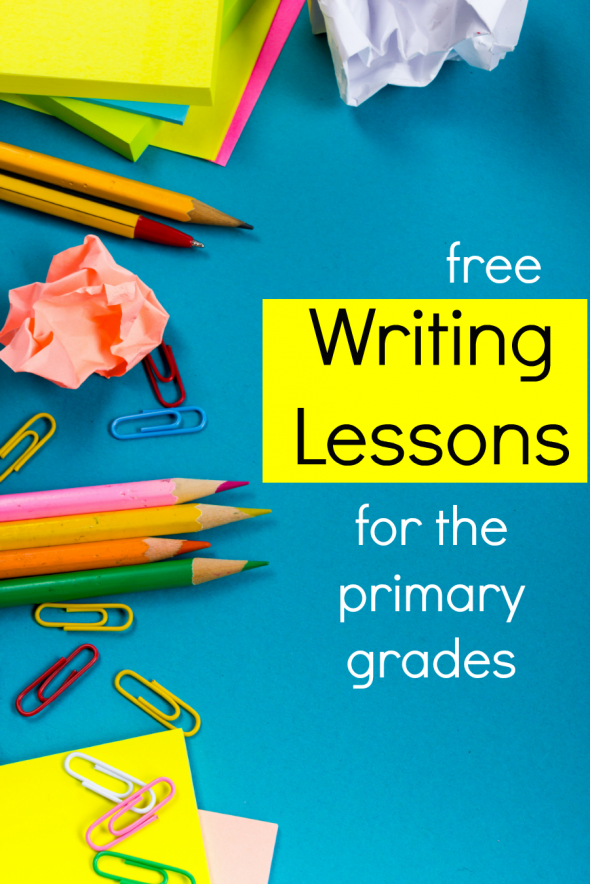
Simple writing lessons.
What comes to mind when you hear those words? Maybe it’s a collection of writing prompts that students respond to in their daily journals. Perhaps you’re thinking of a series of worksheets to help children practice capitalization, parts of speech, and proper spelling. Or maybe you’re hoping for a curriculum which simplifies your teaching by listing every lesson from September to May.
The fact is that teaching writing is not as simple as prompts, drills, or a prescribed curriculum.
What are simple writing lessons?
1. Simple writing lessons differ from traditional writing instruction.
In our writing series you won’t find a series of daily prompts. You will find lessons which show students how to find and choose their own topics.
You probably won’t find children completing a piece of writing in a single sitting. You will find students taking some of their writing all the way through the writing process over days or even weeks.
You won’t find children limited to writing only the words they can spell. You will find students spelling any of the words in their vocabulary — according to their own developmental level.
You won’t find a series of lessons mapped out before the year begins. You will learn to choose what to teach based on your students’ current needs.
2. Simple writing lessons are taught as students follow the writing process.
If you’re focused on the process, then you’re interested in the journey. The destination is important, but you’re most interested in what it takes to get there.
Quality writing instruction takes students through the writing process – over days or even weeks.
Pre-writing: Writers decide on a topic and brainstorm ideas.
Drafting: Writers write sentences and paragraphs, reread what they’ve written, and get suggestions from others.
Revising: Writers rearrange words or sentences, add or delete, replace words, and make sure their writing is fluent.
Editing: Writers correct grammar, spelling, and punctuation.
Publishing/Sharing: Writers create a final copy of their work and share it.
3. Simple writing lessons include a mini-lesson in which teachers clearly model a skill or strategy.
Mini-lessons are just that: mini. They can be as short as 2 minutes and might take as long as 15. Teachers model the lesson with their own writing.
Hundreds of possibilities exist for mini-lessons! Here are just a few:
- Choosing a topic
- How to stretch a word and write the sounds you hear
- Using quotation marks correctly
- Reread your writing to check for fluency
- What to do when you’re “stuck”
- How to follow an editor’s checklist
4. Simple writing lessons leave the bulk of time for students to write independently.
We didn’t teach our toddlers to talk by drilling them on blends and word endings. We talked with them in real and meaningful ways.
We don’t need to drill our children on the skills of good writing. Instead, we give them opportunities to write in real and purposeful ways – and we support and teach them as they grow.
Primary students should be given at least 20-30 minutes to write independently – ideally on a daily basis.
5. We choose simple writing lessons based on observations of our student writers.
A teacher’s manual might tell me that the next writing lesson is about how to insert information by using a caret. But my first grader takes 20 minutes to write a single sentence and is clearly not ready for this advanced revising skill.
Or maybe the prescribed lesson is for putting periods at the end of sentences. My first grader has been doing that correctly for a year. Clearly she needs to learn something else.
Choosing what to teach based on our students’ needs isn’t easy. But the more you do it, the more proficient you’ll become. And The Measured Mom and This Reading Mama are here to help!
6. Simple Writing Lessons for Primary Grades:
Our lessons are designed for students in grades 1 and 2. But you might find that your kindergartner or third grader will also benefit.
- Pre-writing: Make an expert list
- Pre-writing: Use a graphic organizer
- Drafting: Choose a tiny topic
- Drafting: Make it interesting for the reader
- Drafting: Ask questions
- Drafting: Use invented spelling
- Revising: Put boring words in jail
- Revising: Re-read your writing
- Editing: Use a spelling dictionary for kids
- Editing: Use a checklist
- Publishing: Make a book
- Publishing: Share Your Writing
Free Spelling Games
Get this fun variety of sample spelling games from the membership site! The download includes resources for spelling CVCE words, long vowel teams, and multi-syllable words.
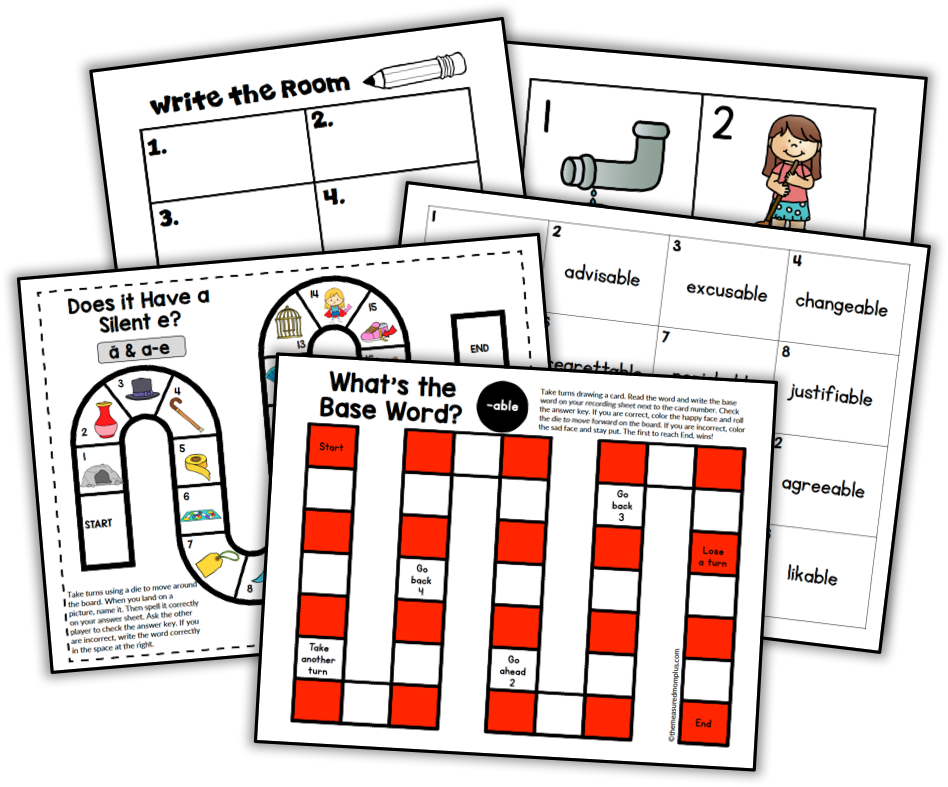
You May Also Enjoy These Posts:
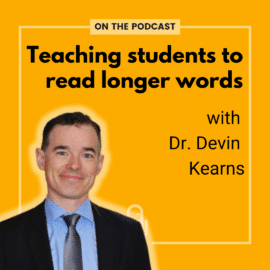
Reader Interactions
36 comments.
Ana Aciar Ochoa
May 28, 2020 at 9:37 am
What a great idea! Thank you!!! <3
Martha Waltz
May 28, 2022 at 1:23 pm
Where can I find your Simple Writing lessons to download?
Laura Cherney
June 2, 2022 at 9:05 am
Hi Martha! You can find Anna’s blog series on Simple Writing Lessons beginning here: https://www.themeasuredmom.com/simple-writing-lessons-for-primary-grades-series/ If you have any other questions, please feel free to contact us at [email protected] Thank you!
September 9, 2015 at 12:53 pm
Hi! Thanks for sharing. These are great!! This helped me search for free printable worksheets that will be helpful for my classroom. I actually found a lot of free worksheets at EduCents.com. There’s a good compare and contrast freebie right now that my kids loved! They love Venn Diagrams, and so do I 🙂 🙂 I’m excited to try your boring words activity next.
Thanks again!
Ms. Bee from California!
Anna Geiger
October 4, 2015 at 3:19 pm
You’re very welcome – thanks so much for reading!
March 1, 2015 at 12:19 pm
please let me know some ideas of how to carry a mini-lesson for cohesive writing. It is for 3rd graders
March 1, 2015 at 12:49 pm
Can you give me some more detailsl about what you’re looking for, Athy?
sims 4 trailer
July 16, 2014 at 8:12 am
Hello, its pleasant post about media print, we all understand media is a enormous source of information.
Donna Valentine-Mutimbanyoka
June 23, 2014 at 2:59 am
Loving all YOU ARE SHARING., ITS GREAT HELP.I am qualified early childhood teacher in Botswana, and am planning to open my own preschool soon. God bless you
May 8, 2014 at 12:35 am
Thank you so much for replying to my post-now I can’t find it! So, I am replying to this one! I was also thinking of doing this writing at the kitchen table to “remove” it from the rest of school! ( Our homeschool does not have room for a table for us to work together at, but if we move next year, that will be a priority! )
They have fallen in love with Zotz candy, so I think we may do “Zotz and Zotz” of writing!
May 14, 2014 at 12:58 pm
Great idea, Jenny! I’d love to hear how it goes.
January 5, 2014 at 6:45 am
Hi Anna, for some reason your link to “Revising: Re-Read Your Writing” doesn’t work this morning. I found the post on Becky’s site, but I thought I’d let you know. 🙂
January 12, 2014 at 4:41 pm
Thanks so much for alerting me to that, Heather. Fixed now!
October 16, 2013 at 12:16 pm
THANK YOU so much for this!!!!! My daughter (3rd grade) has always, always been a struggling writer.
We started out using Abeka’s Language Arts in first grade. It seemed to hop everywhere and the writing parts were more along the lines of: “Write a sentence about this picture” or “Use the following words to write about Abraham Lincoln”. How in the world could my first grader do that? She had no clue how to put ideas into words. Tears, frustration, pushing, exasperation… finally I just put it aside. I focused on the more phonics side of language and skipped the writing assignments.
For second grade, I created a fun parts of speech curriculum. I thought that understanding what a noun and verb is would help her create simple sentences, then from there, she could add adjectives and adverbs to make it more interesting. She understood everything very well, but could not write a sentence of her own creation. “I don’t know what to write!!!”, followed by loads of tears. I turned to Teachers Pay Teachers to find things that public school teachers use with their students… mostly more writing prompts. Second grade passed and it was another writing fail.
This year, I was determined to have a child who could create and write her own thoughts and stories. I’ve tried a few things on my own… still no results.
Sunday, I came across this series and decided to give it a try. Monday, my daughter made an expert list (mostly with my prompting). Tuesday, I took one of my expert topics (taking care of babies) and wrote a paragraph that was “all over the place” while she observed. On her own, she commented that I wrote about too many things. So I had her help me find the tiny topics. Then I chose one and wrote a new paragraph as she watched.
She was smiling (not crying) and I saw the light bulb turn on. She chose one of her expert topics (make-up) and wrote a list of tiny topics. Then chose the tiny topic (blush) and wrote a 27 word paragraph. She forgot everything about capitalization and punctuation, but I was so happy she actually created content that I didn’t even care.
I figured we’d repeat the same sort of thing today… pick an expert topic, break it down, write about a tiny topic… but her dad requested she write something for him today, and she was determined she would write a story not a non-fiction paragraph.
I hesitated sure that this would be an epic fail splashed with a boat load of tears, but I hated to squelch her enthusiasm. I printed out your fiction organizer ans had her start with that. She filled it out, told her story out loud, and then proceeded to write it out.
Today, my daughter wrote a story that nearly filled an entire page.
THANK YOU!!!!!
October 22, 2013 at 8:25 pm
Brenda, I want to thank you SO much for your comment. I can’t tell you how much it made my day to receive it! I love all the details you shared and appreciate knowing that our writing series helped your daughter overcome her writing block. As you know, all writers hit bumps along the way, so please feel free to come back here with questions or concerns about future writing projects. Thanks again!!
September 27, 2013 at 8:57 pm
Hi Anna, I’m excited to use this series with our two homeschooled kids, in 1st and 2nd grades. Right now I’m piecing together their writing curriculum, and I’m wondering, do you have a curriculum you’d recommend where I’d find all this good stuff in one package? It would be reassuring to me that I wouldn’t be leaving anything out. 🙂
Thanks, Heather
September 29, 2013 at 3:31 pm
Very good question, Heather – I’m not sure if something like that exists – partly because Writing Workshop is meant to be designed to respond to the child, and not to a prescribed curriculum. However, you can find lots of places with lists of possible mini-lessons, which I like to use as a reference. I put together a list of sample lessons to work from as we write this series — not how to teach, but a list of ideas. I will send it out to you via e-mail. Let me know if you’re looking for something else in particular!
January 15, 2017 at 11:10 am
This sounds great! I would love a copy too if you’re willing to share. Thank you!
January 15, 2017 at 12:11 pm
Hi Amy! I don’t email these out anymore, as I put all the resources together in my ebook, which is referenced in this post. However, if you follow by email I will eventually be sharing posts with suggested mini-lessons. 🙂
August 14, 2013 at 6:06 am
Looking forward to this series! I featured this post on Mom’s Library this week!
August 19, 2013 at 1:24 pm
Thank you so much for the feature, Ashley!
August 5, 2013 at 9:09 pm
I have one of your spelling games all ready to go. And I’m also hoping to get some of the word family games constructed. And I plan to use a couple math ideas for centers this year. And here you are helping me to get my students writing, too!! And, and, and… how I wish it were early July instead of late August. Thank you so much for all the wonderful ideas!
August 5, 2013 at 9:39 pm
Your comment brings a big smile to my face, Margie 🙂 Thanks so much for tuning in – as our little girl moves into first grade I should have lots more to share for older kids!
August 4, 2013 at 6:03 pm
This sounds wonderful! I’ll be following along 🙂
Thanks, Linda! I hope it’s really useful for you.
Shaunna @ Fantastic Fun and Learning
August 3, 2013 at 6:26 am
This is going to be a great series! I look forward to following along.
August 5, 2013 at 9:38 pm
Thanks for tuning in, Shaunna! We’re excited!
August 2, 2013 at 1:20 pm
Sounds like this is going to be a great series. I can’t wait to see more! 🙂
August 2, 2013 at 8:10 pm
I’m so glad you’re tuned in, Kirstylee! Becky and I are so pumped – it’s just love having a reason to pull out all my old teaching books and brain:).
Tenida Plummer
September 17, 2017 at 10:16 am
Thank you so very much Anna!!!! You have been a life saver in my classroom. The material and tips are so very helpful and saves a lot of my valuable time.
[…] Simple Writing Lessons for Primary Grades (a 12-part series) […]
[…] wonderful explanation and guide to the writing process for budding writers from The Measured […]
[…] of the year is…’ I have been scrapping those altogether and instead going through the Simple Writing Series from The Measured Mom. I am seriously considering switching to Primary Language Lessons next […]
[…] The Measured Mom – Check out her Simple Writing series. […]
[…] strategies for opening and closing sentences. We are currently working through these Simple Writing Lessons for Primary Grades by The Measured Mom. They are an excellent introduction. She works with her first […]
[…] am super pumped to announce an upcoming and awesome series that Anna of The Measured Mom and I are tackling together: Simple Writing Lessons for Primary Grades {for 1st and 2nd grades}. […]
Leave a Comment Cancel reply
Your email address will not be published. Required fields are marked *
This site uses Akismet to reduce spam. Learn how your comment data is processed .
Science of Reading Resources
Popular freebies.
Get instant access to science of reading workshops and over 2000 printable resources!
Become a Member
- Grades 6-12
- School Leaders
Have you entered our back-to-school giveaway? ✨
101 Interesting Persuasive Essay Topics for Kids and Teens
Use your words to sway the reader.
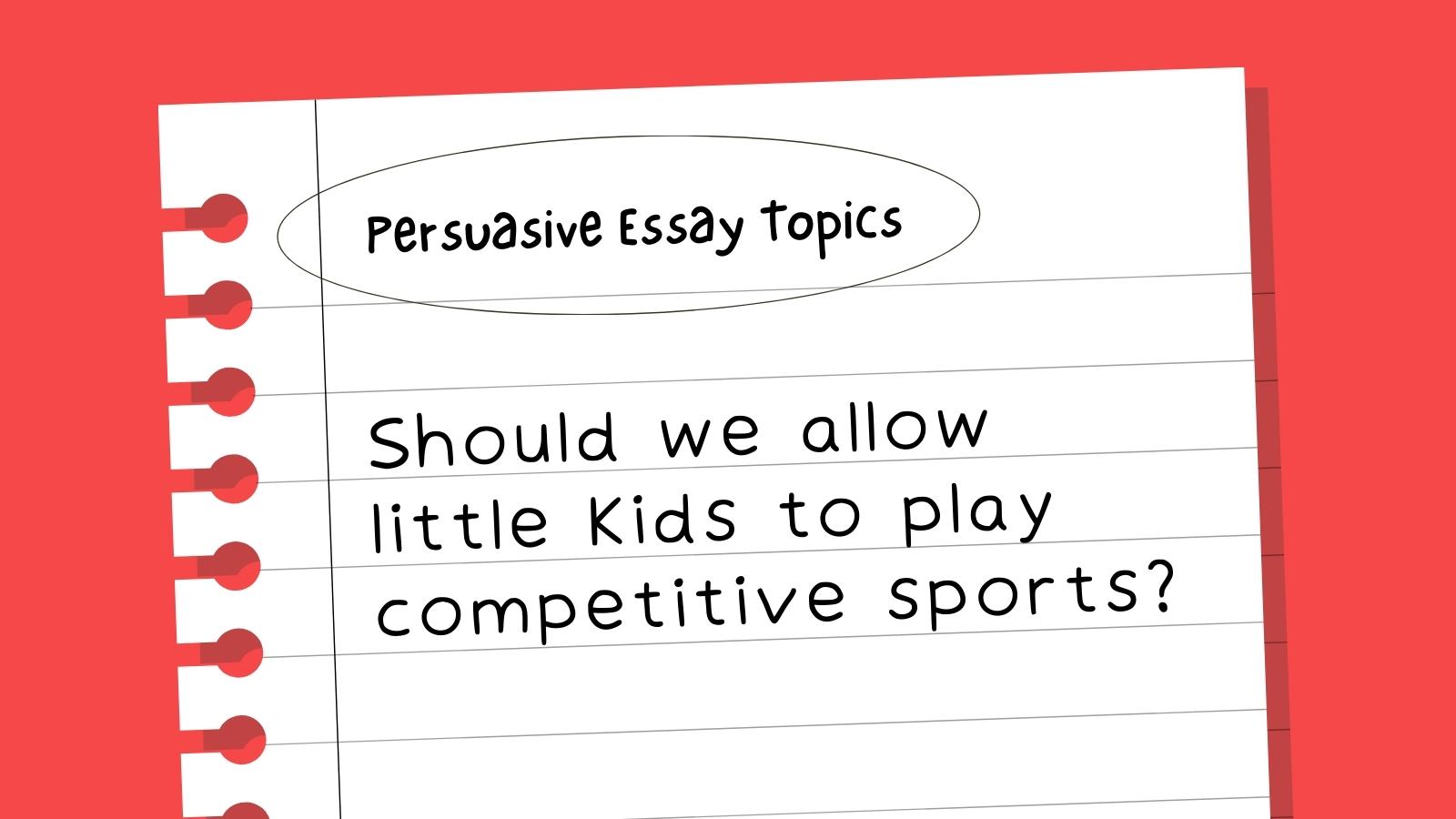
Persuasive writing is one of those skills that can help students succeed in real life. Persuasive essays are similar to argumentative , but they rely less on facts and more on emotion to sway the reader. It’s important to know your audience so you can anticipate any counterarguments they might make and try to overcome them. Try reading some mentor texts to show kids great examples of opinion writing. Then use these persuasive essay topics for practice.
School and Education Persuasive Essay Topics
Life and ethics persuasive essay topics, science and technology persuasive essay topics, sports and entertainment persuasive essay topics, just for fun persuasive essay topics.
- Do you think homework should be required, optional, or not given at all?

- Students should/should not be able to use their phones during the school day.
- Should schools have dress codes?
- If I could change one school rule, it would be …
- Is year-round school a good idea?
- Should we stop giving final exams?
- Is it better to be good at academics or good at sports?
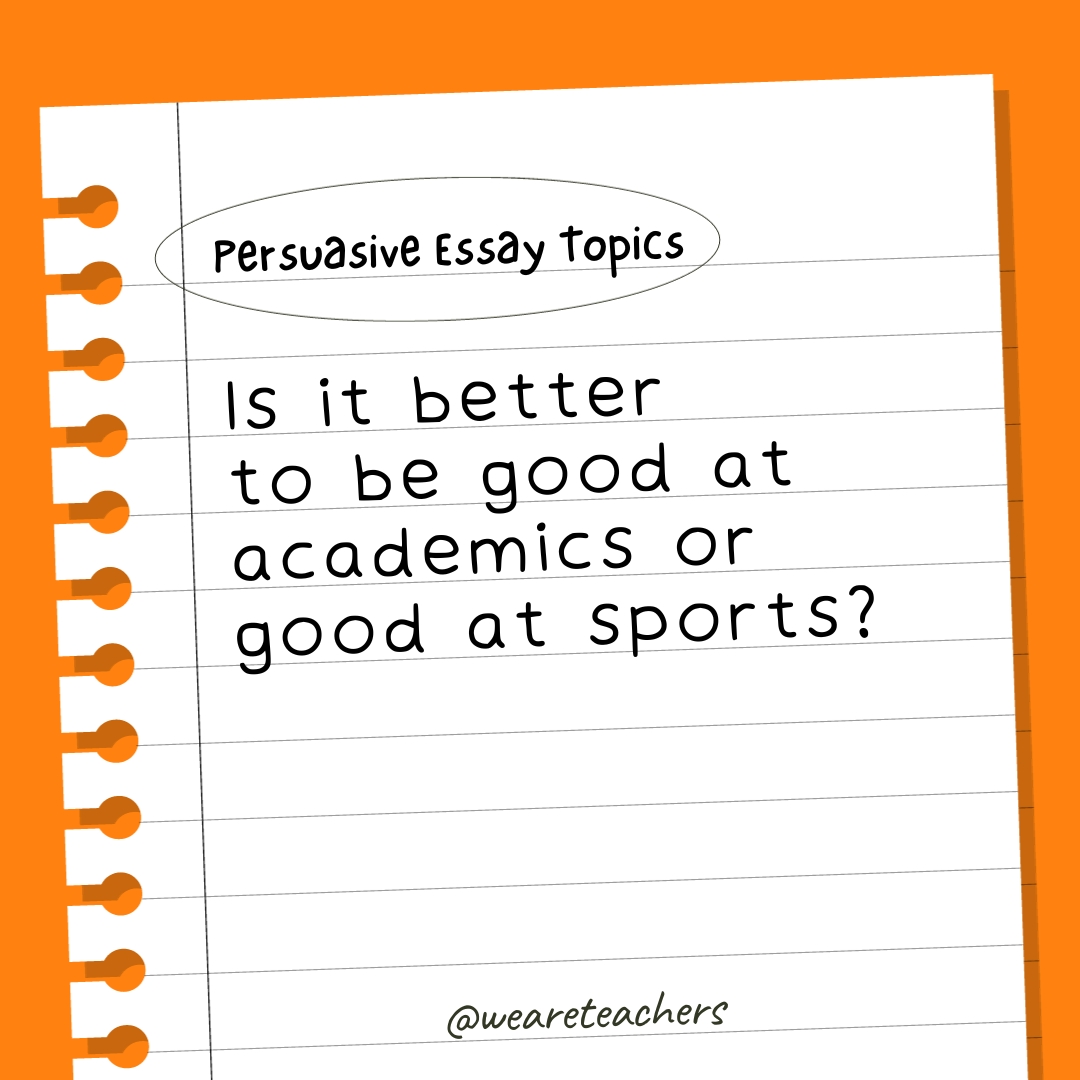
- Which is better, private schools or public schools?
- Should every student have to participate in athletics?
- Do you think schools should ban junk food from their cafeterias?
- Should students be required to volunteer in their communities?
- What is the most important school subject?
- Are letter grades helpful, or should we replace them with something else?
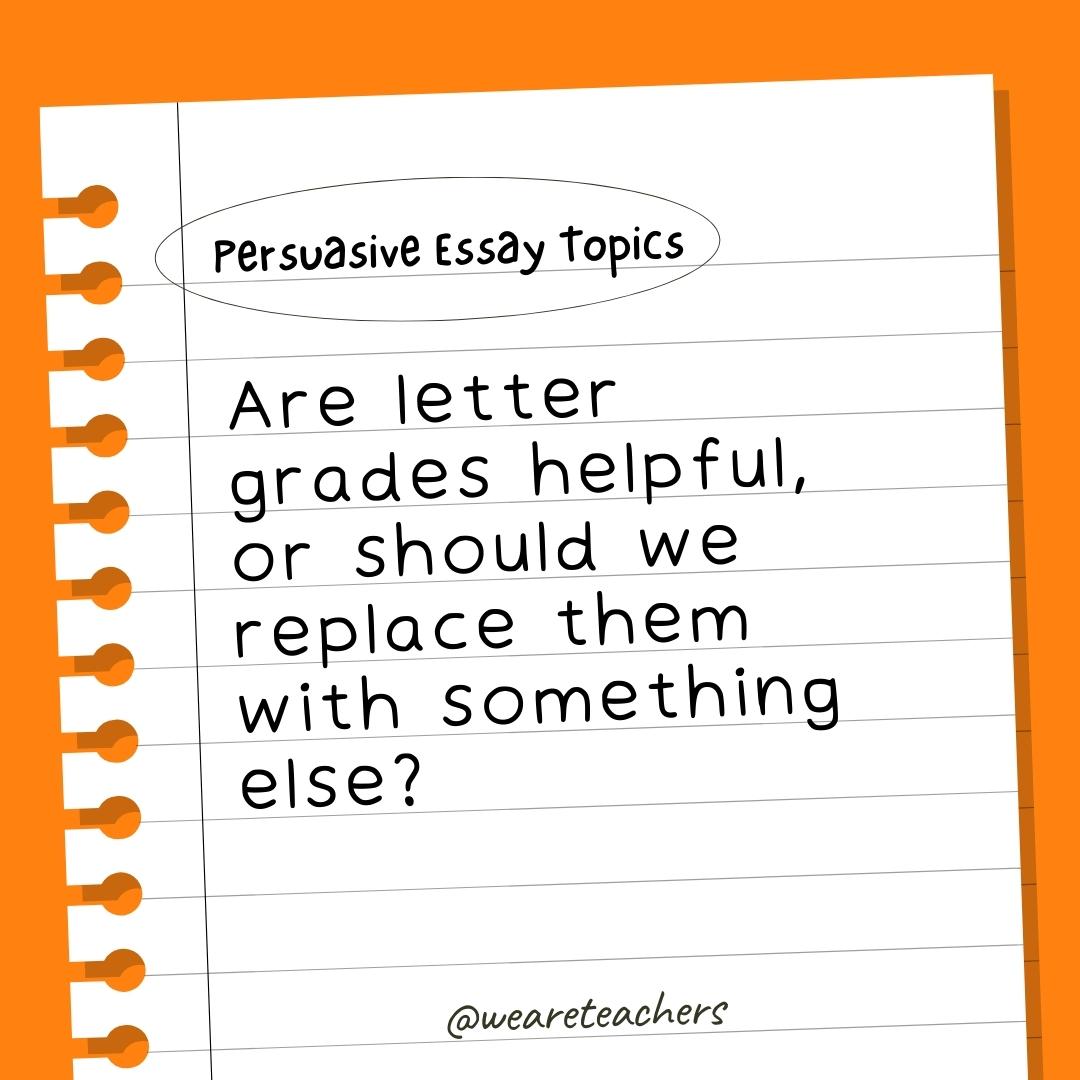
- Is it ever OK to cheat on homework or a test?
- Should students get to grade their teachers?
- Do you think college should be free for anyone who wants to attend?
- Should schools be allowed to ban some books from their libraries?
- Which is better, book smarts or street smarts?
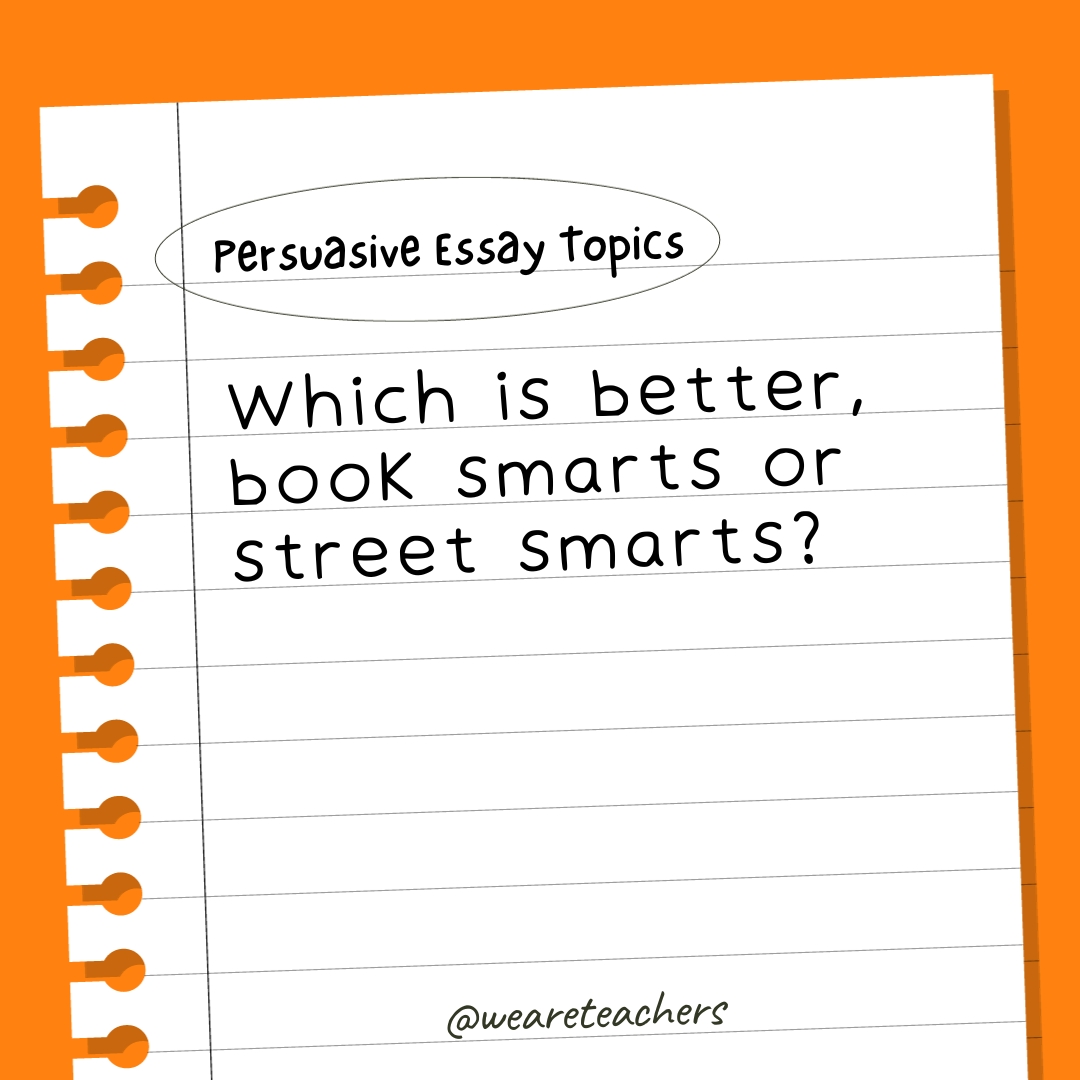
- Should all students have to learn a foreign language?
- Are single-gender schools better or worse for students?
- Is it OK to eat animals?
- What animal makes the best pet?
- Visit an animal shelter, choose an animal that needs a home, and write an essay persuading someone to adopt that animal.
- If you find money on the ground, should you try to find the person who lost it, or is it yours to keep?
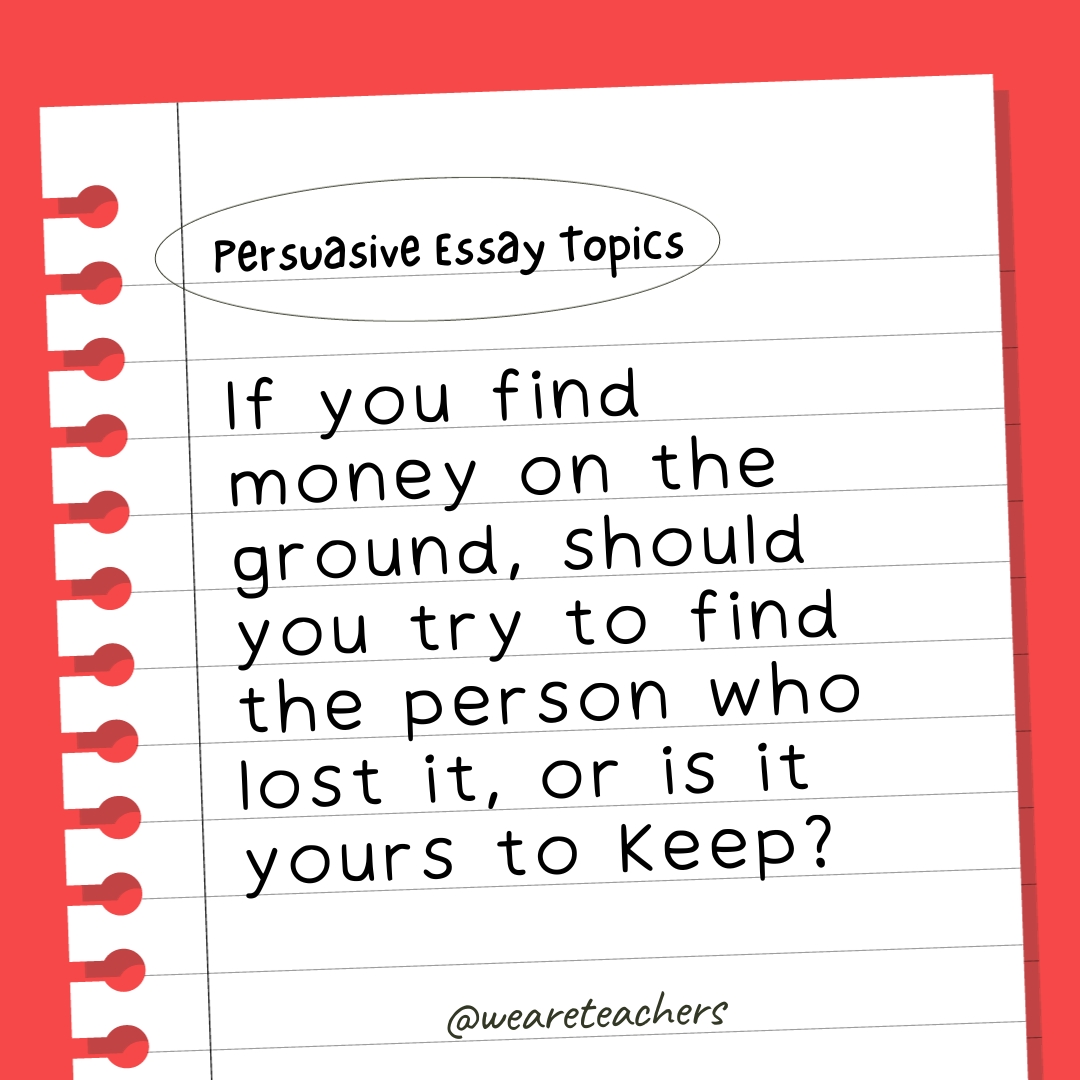
- Who faces more peer pressure, girls or boys?
- Should all Americans be required to vote?
- Is it better to be kind or truthful?
- Which is better, giving or receiving?
- Is it OK to keep animals in zoos?
- Should we change the minimum driving age in the United States?
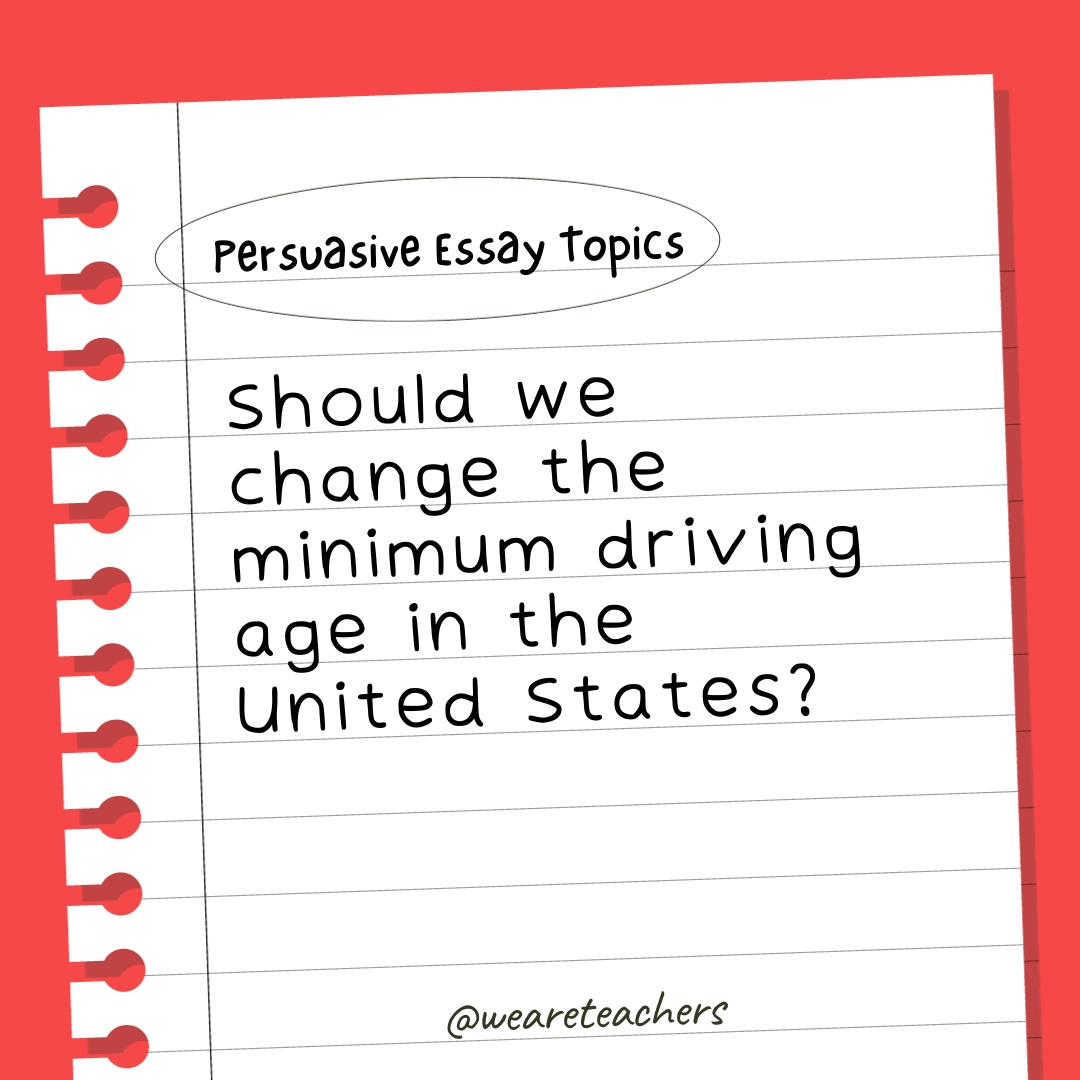
- Which is more important, happiness or success?
- Is democracy the best form of government?
- Is social media helpful or harmful?
- Should parents be punished for their children’s mistakes or crimes?
- Should kids have set bedtimes or just go to bed when they’re sleepy?
- Do you think the government should find a way to provide free health care for everyone?
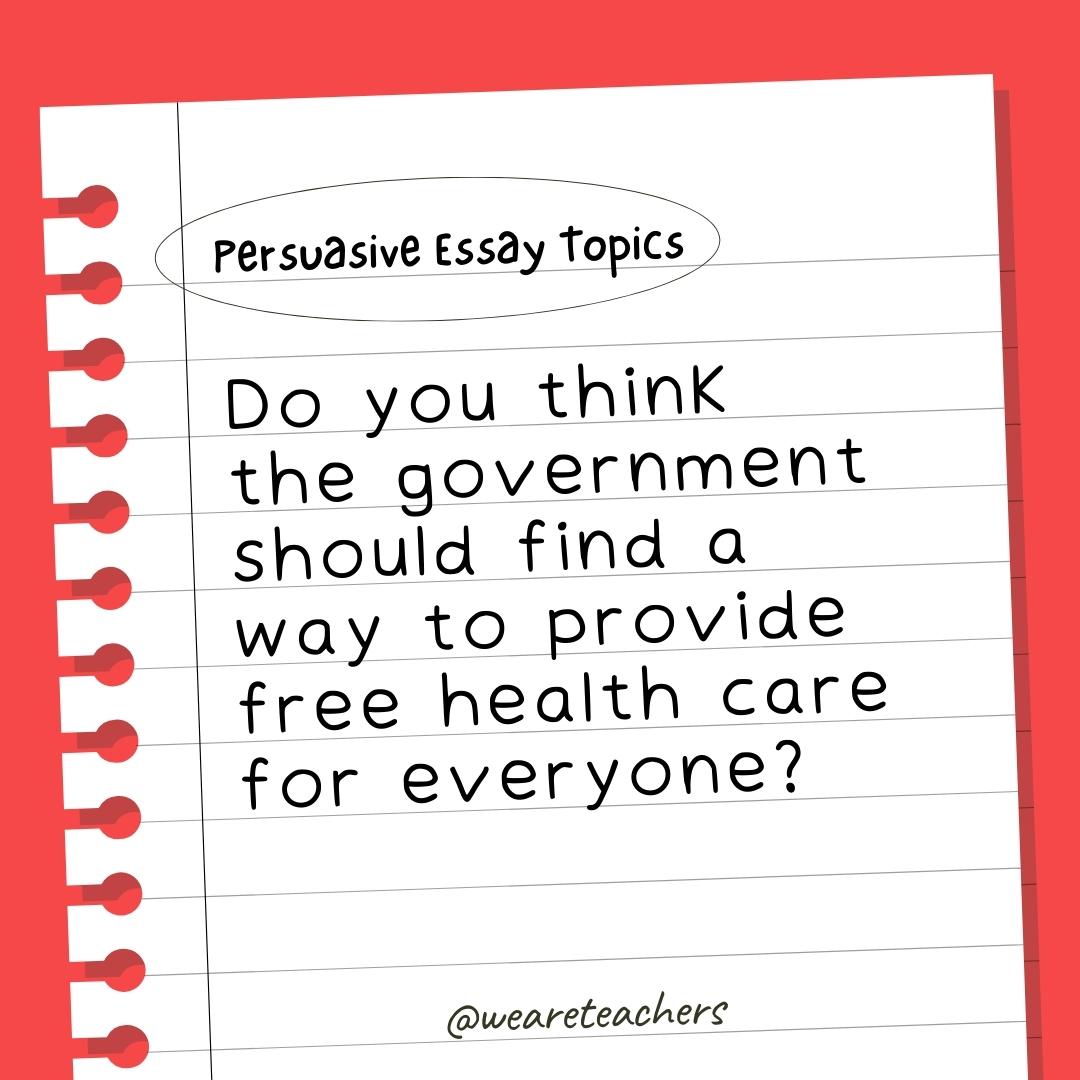
- Is it better to save your allowance or spend it?
- Should we ban plastic bags and bottles?
- Which is better, living in the city or in the country?
- If I could make a new law, it would be …
- Is Pluto a planet?
- Should human cloning be legal?
- Should vaccines be mandatory?
- Is it right for countries to still maintain nuclear weapon arsenals?
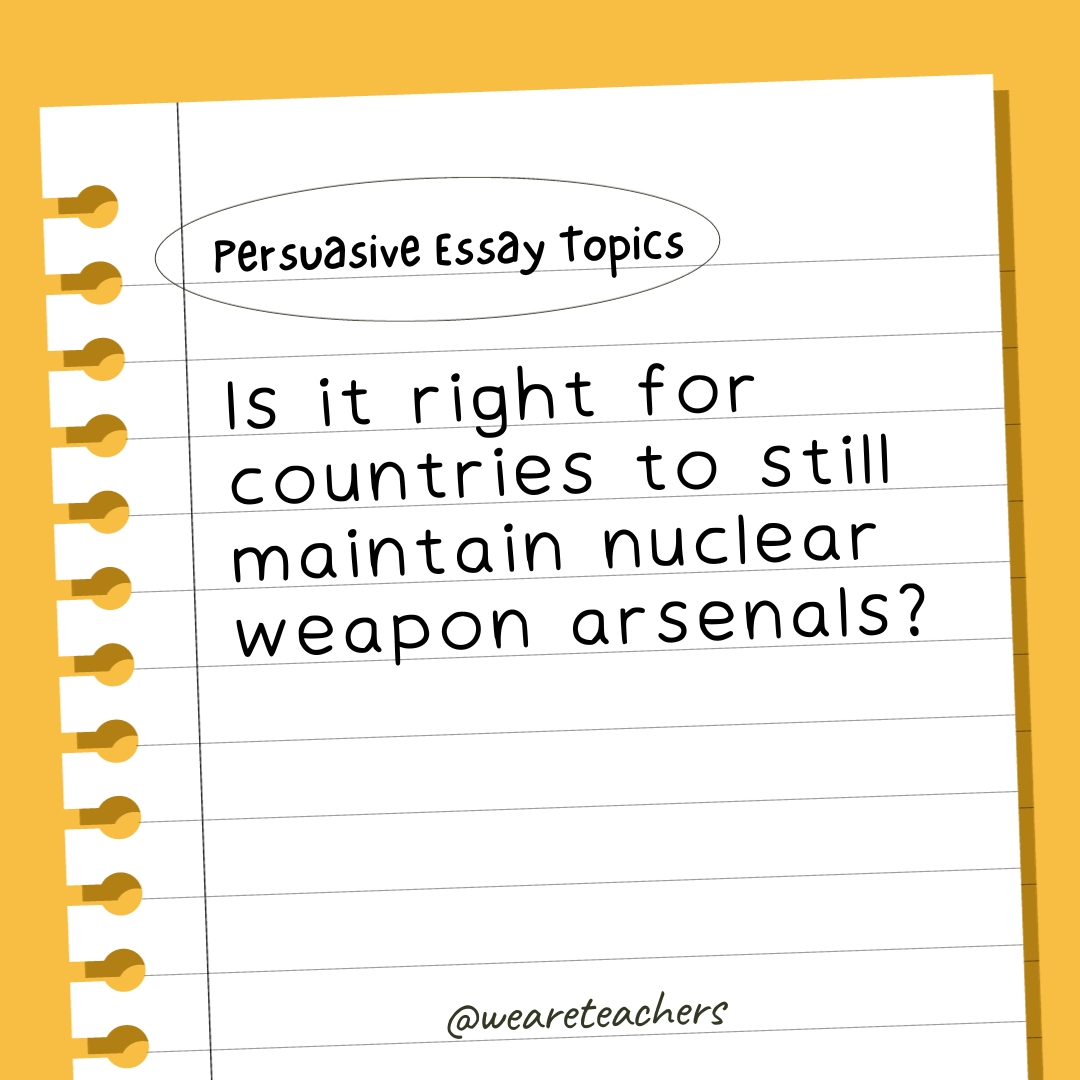
- Should testing on animals be made illegal?
- Will expanded use of artificial intelligence be good for humanity?
- Should all people have free Internet access in their homes?
- Is there intelligent life on other planets?
- Does technology create more jobs than it eliminates?
- Should parents use their children’s cell phones to track where they are?
- Should scientists try to develop a way for people to live forever?
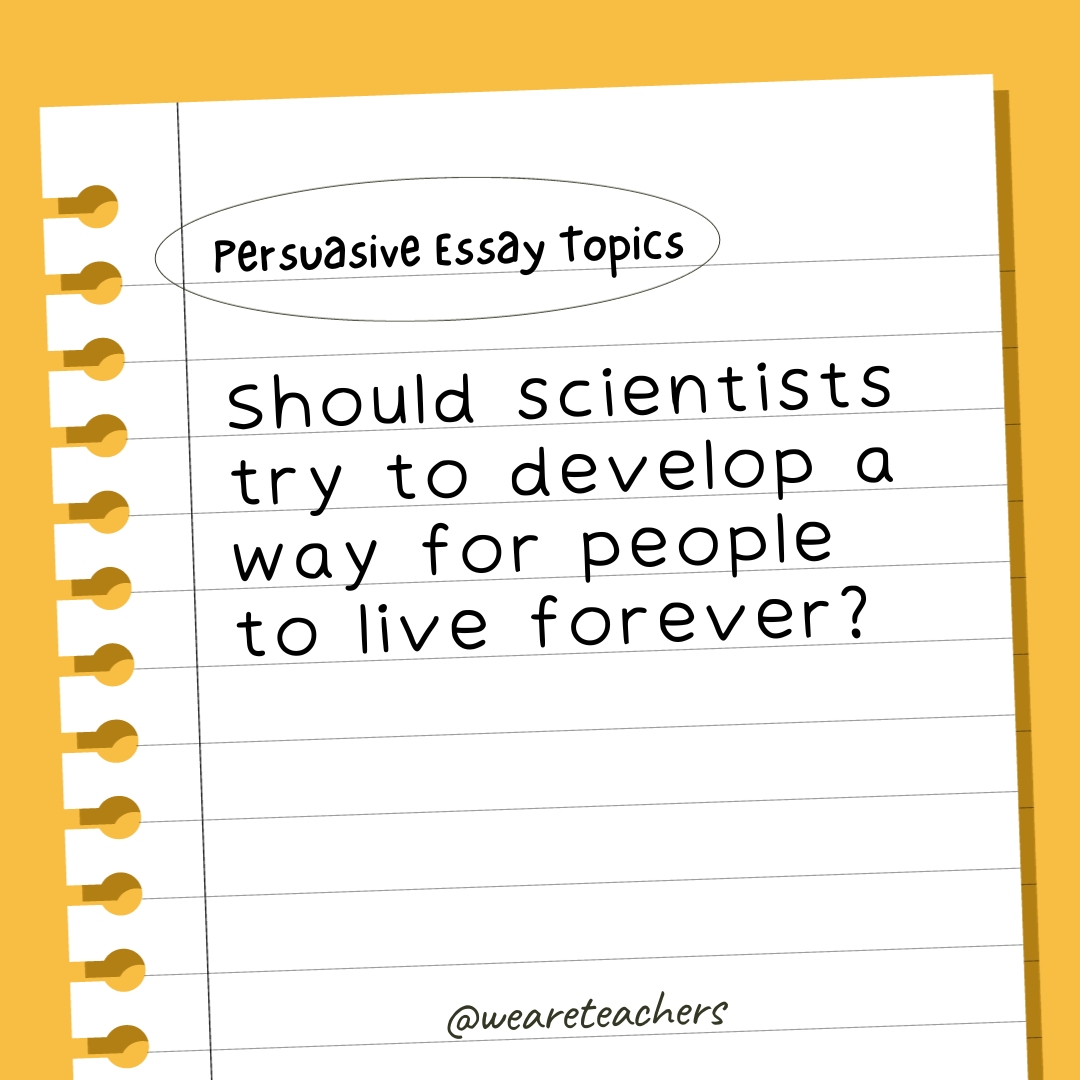
- What’s the best type of smartphone: Android or iPhone?
- Which is better, Macs or PCs?
- Do people rely too much on technology in the modern world?
- Should cryptocurrencies replace cash?
- Should there be a minimum age requirement to own a smartphone?
- Is it important to keep spending money on space exploration, or should we use the money for other things?

- Should kids under 13 be allowed to use social media sites?
- Should we ban cigarette smoking and vaping entirely?
- Is it better to be an animal that lives in the water or on land?
- Should kids be allowed to watch TV on school nights?
- Which is better, paper books or e-books?
- Is the current movie rating system (G, PG, PG-13, etc.) effective?
- Are video games better than board games?
- Should we allow little kids to play competitive sports?
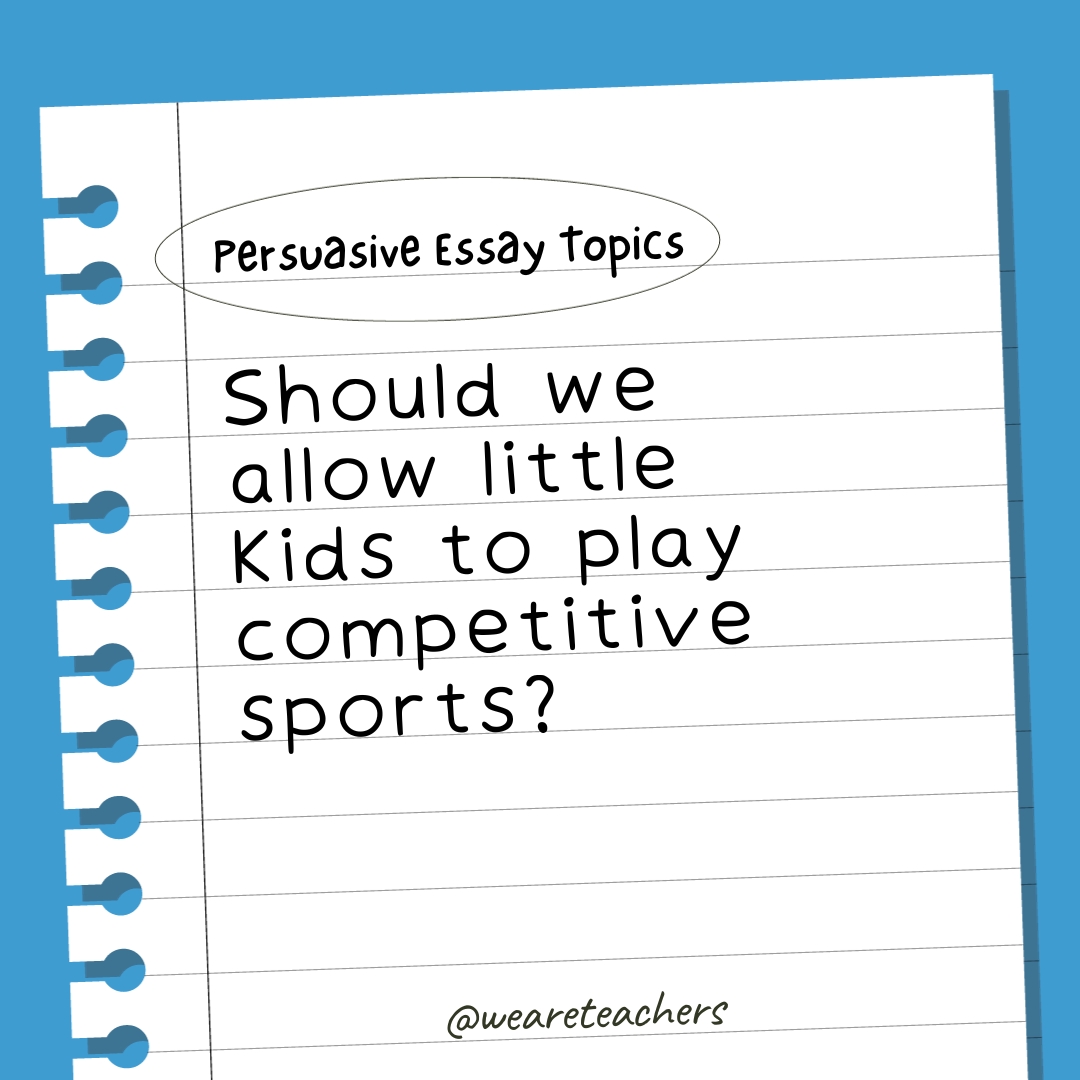
- Which is better, reading books or watching TV?
- Does playing violent video games make people more violent in real life?
- Are graphic novels just as valuable as traditional fictional books?
- Should everyone play on the same sports teams, regardless of gender?
- Choose a book that’s been made into a movie. Which was better, the movie or the book?

- Who is the world’s best athlete, present or past?
- Are professional athletes/musicians/actors overpaid?
- Which is better, fiction or nonfiction?
- The best music genre is …
- What is one book that everyone should read?
- What new sport should be added to the Olympics?
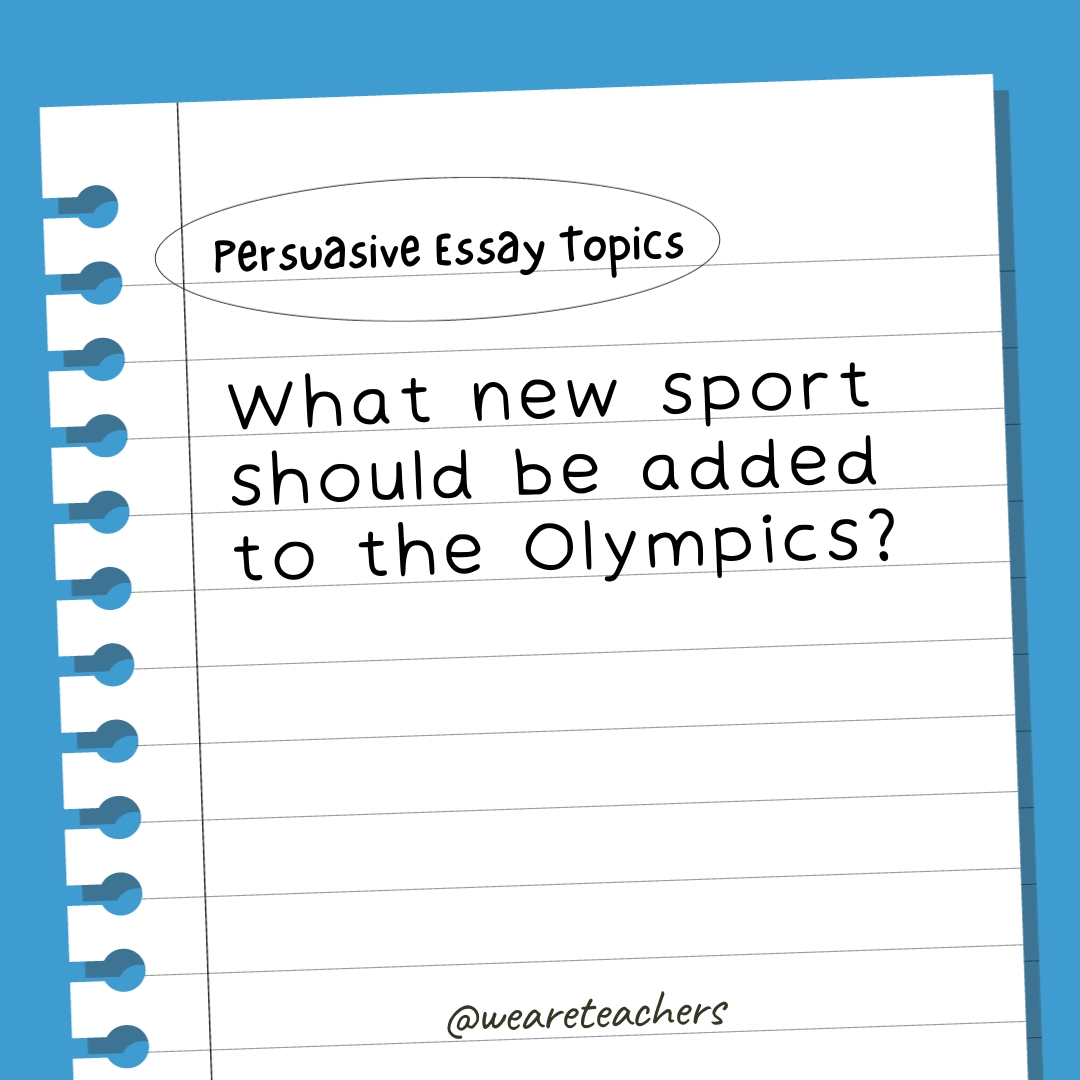
- What’s the best video game system?
- Does playing video games make you smarter?
- Does reality TV actually depict real life?
- Should all neighborhoods have free parks and playgrounds?
- What’s the best holiday?
- The very best food of all time is …
- Which is better, artificial Christmas trees or real ones?
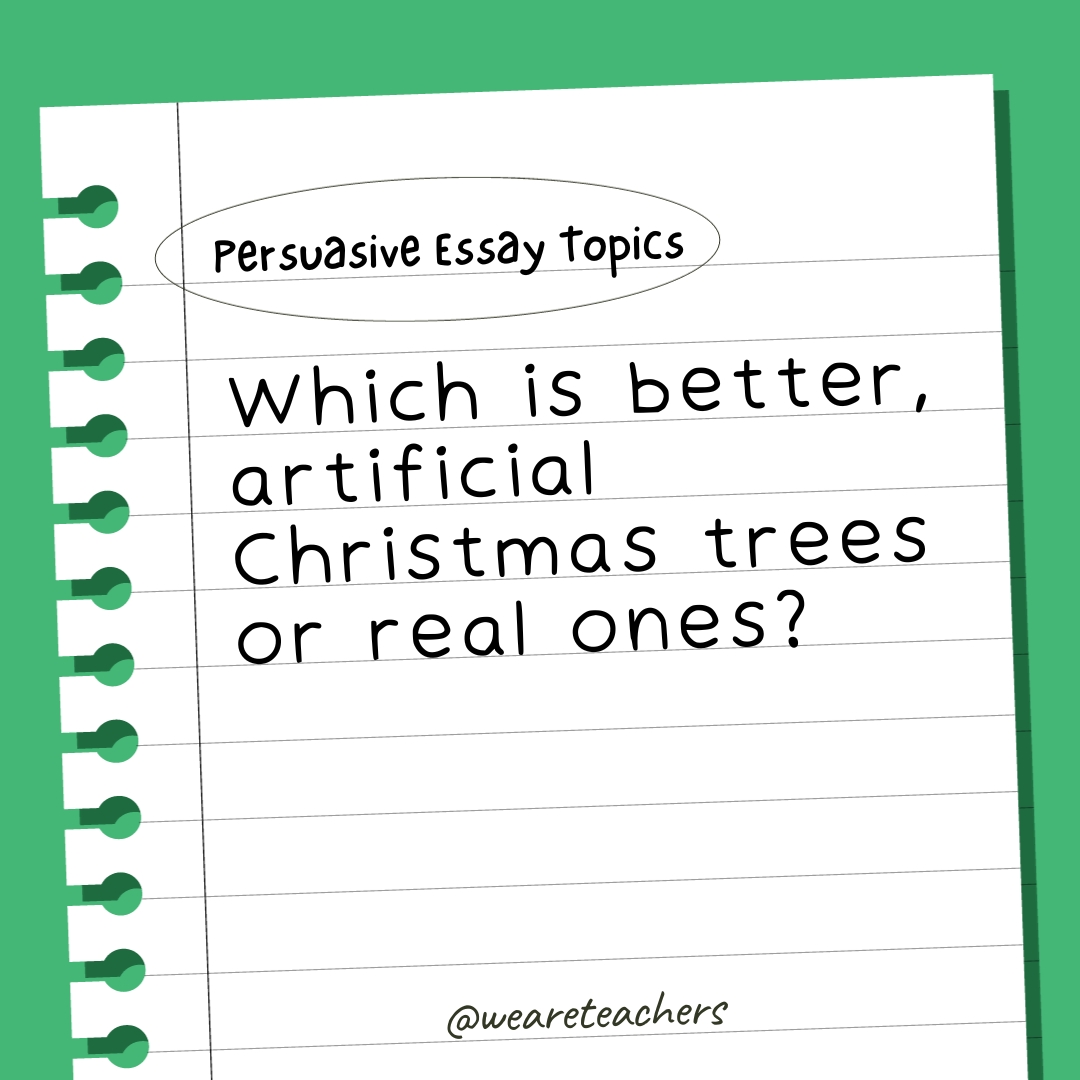
- What’s the best season of the year?
- Should you put ketchup on a hot dog?
- Is a taco a sandwich?
- Does fruit count as dessert?
- Should people have to go to school or work on their birthday?
- Are clowns scary or funny?
- Which is more dangerous, werewolves or vampires?
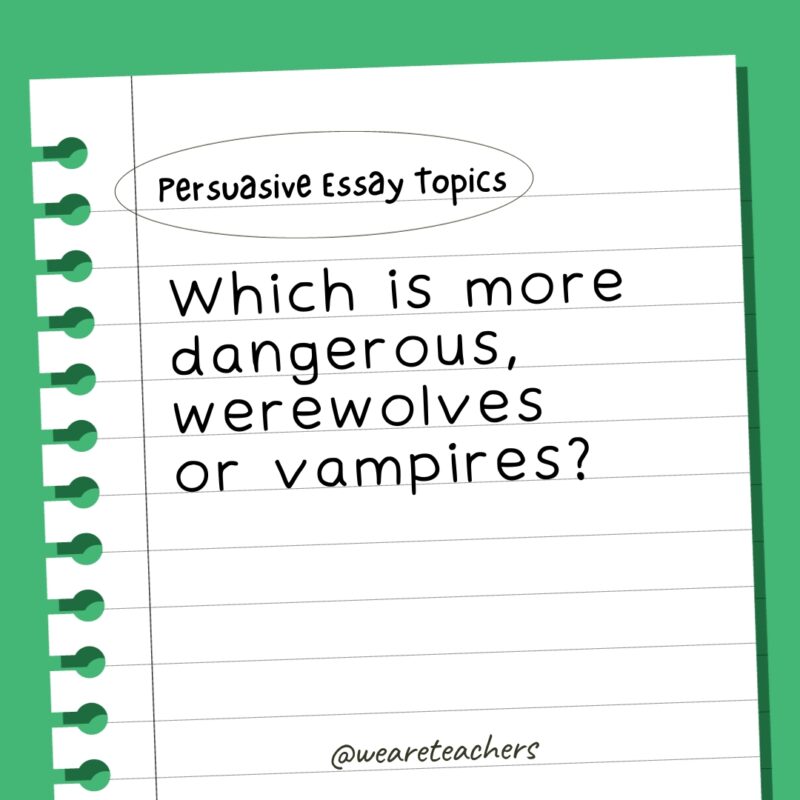
- The best pizza topping is …
- What would be the best superpower to have?
- Should everyone make their bed every day?
- Which came first, the chicken or the egg?
- Should you put pineapple on a pizza?
- Should you eat macaroni and cheese with a spoon or a fork?
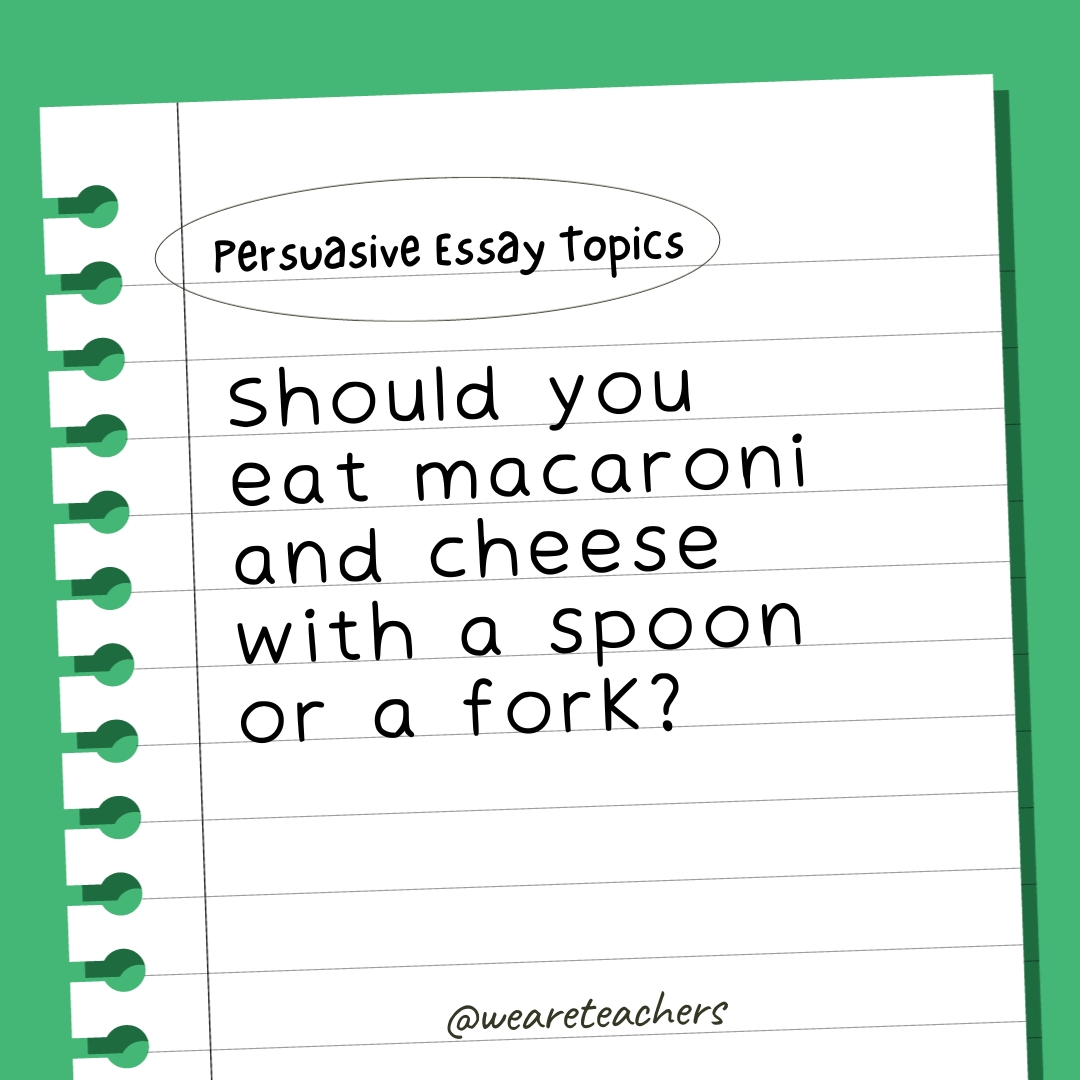
- Describe the world’s best ice cream sundae.
- Is Monday the worst day of the week?
- Would you rather travel back in time or forward in time?
- Is it better to be too hot or too cold?
- Are there aliens living among us here on Earth?
What are your favorite persuasive essay topics for students? Come exchange ideas in the We Are Teachers HELPLINE group on Facebook .
Plus, check out the big list of essay topics for high school (120+ ideas) ..
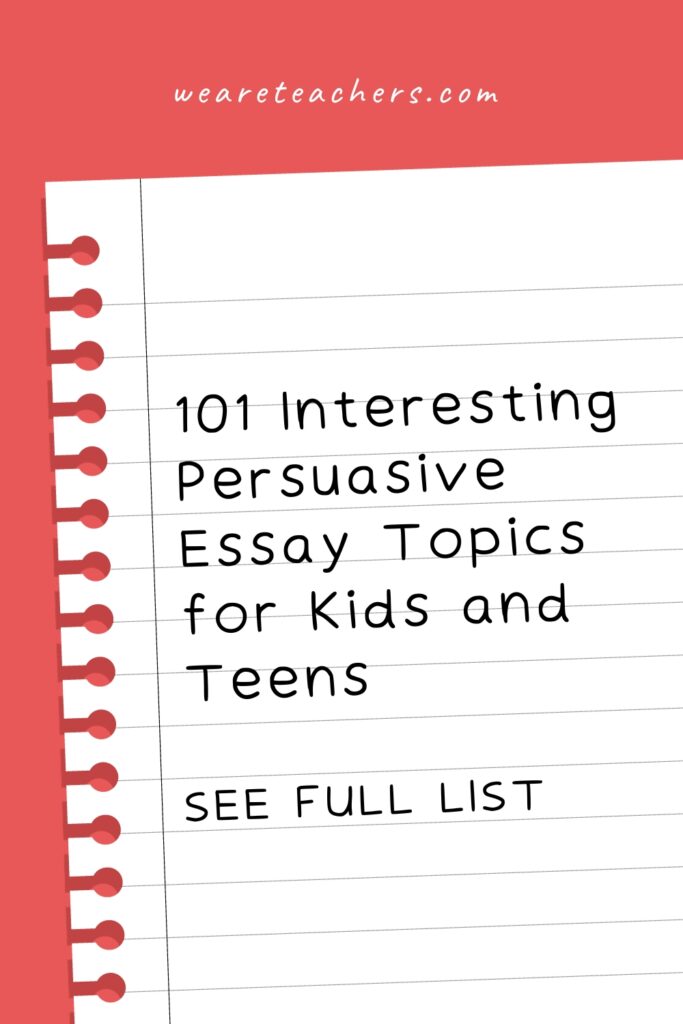
You Might Also Like
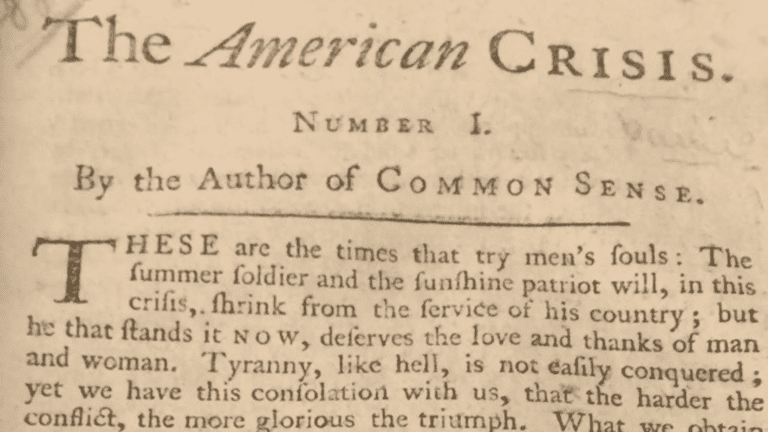
40 Strong Persuasive Writing Examples (Essays, Speeches, Ads, and More)
Learn from the experts. Continue Reading
Copyright © 2024. All rights reserved. 5335 Gate Parkway, Jacksonville, FL 32256

Essay On My Experience In Primary School As A Student
In this short essay a student describe about his experience in a primary school. Enjoy reading these paragraph
My Experience In Primary School As A Student Essay
1. Introduction Paragraph
My first steps into the world of learning was taken during my primary school years – I was introduced to an exciting and vibrant new environment. Not only did I learn how to read, write, do basic math and science but also broaden my social circle by meeting some lifelong friends. Those formative experiences have been instrumental in forming me as a student today!
2. Body sentences
The teachers at my school were extraordinary! Not only did they ensure we had a strong educational foundation, but also an incredibly enjoyable learning experience. I fondly remember the vibrant classrooms with books lining every shelf and our occasional breaks spent in frivolity: playing games or cheering on classmates during sports day. Perhaps most of all, those times outside the classroom – exploring science museums or celebrating cultural festivals – provided us long-lasting memories and lifelong friendships alike.
My primary school experience were a roller coaster ride full of thrilling highs and daunting lows. At times, the pressure to perform in class seemed insurmountable; but with help from teachers and parents, I pushed through these difficulties and achieved success academically.
Reflecting on my primary school experience , I can see the immense value it has had in shaping me into who I am today. It instilled within me core values of ambition and commitment essential for growth which are now integral to every aspect of my life.
3.Conclusion
My primary school journey was a memorable one that has an incredible influence on my future academic endeavors. I am thankful for the wonderful education, encouragement and chances that were presented to me during this time of growth!

Hello! Welcome to my Blog StudyParagraphs.co. My name is Angelina. I am a college professor. I love reading writing for kids students. This blog is full with valuable knowledge for all class students. Thank you for reading my articles.
Related Posts:
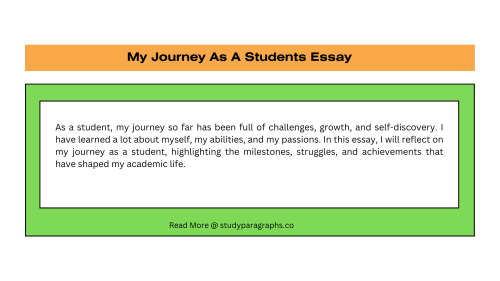
Leave a Reply Cancel reply
Your email address will not be published. Required fields are marked *
Save my name, email, and website in this browser for the next time I comment.
Onlymyenglish.com
Learn English
My School Essay in English (100, 200, 300, 500 words)
Table of Contents
My School Essay 100 Words
My school is a place where I get educated; learn new subjects under the guidance of trained and skilled teachers. I study at a school that is near my home. It is one of the best schools in my entire town. The management of my school believes that it isn’t only academic excellence that we should be after, but also the overall personality development and evolving into a good and useful human being.
The school has two playgrounds – one is a tennis court and the other one is a cricket ground. We also have a nice swimming pool and a canteen. It also has a beautiful garden where students relax and play during recess. Even in games, sports and tournaments, it has made much progress. My school has won many trophies, shields, and medals in many extra-curricular activities. In debates also, the students of my school secure good positions. It is considered to be one of the best schools in my locality.
My School Essay 200 Words
The school is called the educational institution which is designed to provide learning spaces and create an environment for the children where the teaching of the students is under the direction and guidance of the teachers.
My School is one of the best educational institutions where I get an education and make progress towards the goals of my life and make me capable of achieving them. Besides education, there are several significant roles that my school plays in my life. My school is performing well in all fields. It develops my physical and mental stamina, instills confidence, and
gives me tremendous opportunities to prove my skills and talents in different fields. In the academic field, it has made a mark. Its students secure top positions in the board examinations.
I go to school with my other friends. We study in our school in a great friendly environment. We reach school at a fixed time. As soon as we reach we line up to attend the assembly. Attending the school assembly is a wonderful experience. I enjoy for being first in a row in a school assembly. As soon as the assembly ends we rush to our respective classrooms. We take part in all school activities. One of my school fellows is the best singer and dancer. She has recently won the best singer award at the annual arts festival. Our school organizes all-important national events like Independence Day, teachers’ day, father’s day, etc. My school also gives every student abundant opportunities to take part in extracurricular activities like sports and music.
All of us are proud of being a part of it. I am fortunate enough to be a student at this school. I love and am proud of my school.
My School Essay 300 Words
An institution where higher education is taught is commonly called a school, University College, or University. Most countries have systems of formal education, which is sometimes compulsory. In these systems, Students progress through a series of schools. The names for these schools vary by country but generally include primary school for young children and secondary school for teenagers who have completed primary education.
My school is a place where I not only get educated but also get trained in other necessary competitive skills like sports, music, and dance. I am proud of my school because it provides us with all the basic facilities like a big playground, a central library, a big auditorium hall, a science lab, and a good computer lab. That is why my school is rated as one of the best schools in my entire area. My school has produced many great people in my country. It has a big and beautiful building that looks shiny from far away. I reach my target at a fixed time. I came to school with other friends of mine. We happily enter the schools with great confidence. We take part in a school assembly and then we move into our classrooms.
This all is done by a very efficient and well-trained teaching staff of my school. The best schools are those that make the students the best and the best school is made by the best teachers. We study under the guidance of the best teachers. My school has a dedicated teacher for all the subjects as well as extracurricular activities like music and sports. I consider my school as the best school because it supports and encourages every student to do their best and make progress. Fortunately, my school provides the best environment, the best teachers, and the best facilities.
Our Class teacher greets us daily and asks about us. He is quite a cool and kind man. He entertains us along with teaching his subject. We learn a lot of things like discipline, self-help, confidence, and cooperation here. As I enter my classroom I feel quite happy and relaxed.
My School Essay 500 Words
The place where children as the leaders of tomorrow study and where the future of the nation is shaped are called schools. Education is an essential weapon for tomorrow, so the good schools of today are important for the best future of a nation. Schools are the center of learning where we attend classes on various subjects, interact with the teachers, get our queries
answered, and appeared in exams. In my school, learning is more like a fun activity, because of the extra-talented teaching staff.
My school is a government primary school located on the outskirts of the city. Usually, when people think about a government school, they perceive it to be at an isolated location and have poor basic amenities and teaching facilities. But, despite being a government school, my school defies all such speculations. Teachers of my school are not only knowledgeable about the subjects they teach but also are skilled enough to teach through fun activities. For example, our physics teacher explains every concept by stating real-life examples that we could relate to. This way we not only understand the subject better. Moreover, not a moment I remember, when any teacher had ever replied rudely to any of the students. They always patiently listen and provide answers to all the queries posed to them. Learning at my school is fun and it is made possible only because of the teachers.
My school is very important in my life, in a way even more than my family. My family gives me love, care, and affection, and provides for all my other essential needs. But, all of this isn’t enough to make me a good human being and succeed in life. Favorably, I am lucky enough to be enrolled in a prestigious school, and gaining a wonderful education, looking forward to realizing my dreams one day. The most necessary for success in life is education, and only my school provides it to me. Without my school and the education that it gives, I would be like a confused and wandering soul, almost aimless in life.
My school helps with my educational and overall personality development. It imparts education through classes, tests, and exams to teach me how to conduct myself confidently. It just feels so great to be in my school and be a part of everyday activities, be it lectures, sports, or Something else. While in school, I always feel happy, confident, enthusiastic, and loved. I make friends at school, those whom I will never forget and will always love them. My family supports my materialistic needs, but school is the place where my actual physical, social, and mental development takes place. I know that every question that crosses my mind will be answered by my teachers. I also know that my school friends will always be at my side whenever I need them to be. As much as the studies, my school also stresses much on These activities as the management thinks that extracurricular activities are very essential for our overall personality development. My school provides dedicated teachers and staff for each extracurricular activity. We have a big sports ground with kits for all the major sports; a covered auditorium for dance and music and a separate basketball court.
The role my school plays in my personality development is fantastic. It not only imparts education in me but also teaches me how to conduct myself and how to behave decently and properly. I get trained in all the other necessary skills of life, like how to keep calm in challenging situations and help others as well. My school teaches me to be a good and evolved human being, to stay composed and progressive always. It also teaches me to be kind and generous to others and not differentiate them based on their caste, religion, ethnicity, or other divisions. These are some of the most essential personality traits that my school imparts to me, something that I will always be thankful for. Every time I think of my school, I think of it as a temple of education. A temple, where my soul meets education, making my life more meaningful and useful to society and the nation as well. It is a place where my aspirations get a wing and I get the strength and confidence to realize them. No other place in the entire world could replace my school and the role that it plays in my life. I will always be thankful to my friends, teachers, and the staff of my school, for making it such a comfortable and Educational place of learning.
- My Mother Essay
- Republic Day Essay
- Mahatma Gandhi Essay
- Essay on Holi
- Independence Day Essay
- My Family Essay
You might also like
Cow essay in english, health is wealth essay in english.

10 Lines on My School Essay in English
Netaji subhash chandra bose essay in english, my hobby essay in english, my best friend essay in english (100, 200, 300, 500 words).
Essay on My School for Students and Children
500+ words essay on my school.
Education is an essential part of our lives. We are nothing without knowledge, and education is what separates us from others. The main step to acquiring education is enrolling oneself in a school. School serves as the first learning place for most of the people. Similarly, it is the first spark in receiving an education. In this essay on my school, I will tell you why I love my school and what my school has taught me.
We have all been to school and we have loved each and every moment we have spent over there as those were the building blocks of our lives. A school is a place where students are taught the fundamentals of life, as well as how to grow and survive in life. It instils in us values and principles that serve as the foundation for a child’s development.
My school is my second home where I spend most of my time. Above all, it gives me a platform to do better in life and also builds my personality. I feel blessed to study in one of the most prestigious and esteemed schools in the city. In addition, my school has a lot of assets which makes me feel fortunate to be a part of it. Let us look at the essay on my school written below.

Why I Love My School?
From kindergarten through primary and secondary school, and subsequently, to faculty, school is a place where we always study, grow, and establish ourselves, socialize, be a friend, help others, and love and be loved. School is a buddy that will accompany us from the beginning of our youth till the conclusion of our lives. At school, we share all of our pleasures and sorrows, and we constantly rely on one another. This is made possible through the friendships we share. They assist us in effortlessly overcoming difficulties, sharing moments of enjoyment together, and looking forward to new paths.
My school strikes the perfect balance between modern education and vintage architecture. The vintage buildings of my school never fail to mesmerize me with their glorious beauty. However, their vintage architecture does not mean it is outdated, as it is well-equipped with all the contemporary gadgets. I see my school as a lighthouse of education bestowing knowledge as well as ethical conduct upon us.
Teachers have the power to make or break a school. The teaching staff is regarded as the foundation of any educational society. It is their efforts to help kids learn and understand things that instil good habits and values in their students. While some concepts are simple to grasp, others necessitate the use of a skilled teacher to drive the home the idea with each pupil.
In contrast to other schools, my school does not solely focus on academic performance. In other words, it emphasizes on the overall development of their students. Along with our academics, extra-curricular activities are also organized at our school. This is one of the main reasons why I love my school as it does not measure everyone on the same scale. Our hardworking staff gives time to each child to grow at their own pace which instils confidence in them. My school has all the facilities of a library , computer room, playground, basketball court and more, to ensure we have it all at our disposal.
For me, my school is more than simply an educational institution; it is also my second family, which I established during my childhood. A family of wonderful friends, outstanding teachers, and fond school memories. I adore my school because it is where I learn how to be a good citizen and how to reach my goals. School is the only place where we make friends without judging them. We feel comfortable spending time with those close friends no matter what the situation.
Get the huge list of more than 500 Essay Topics and Ideas
What has My School Taught Me?
If someone asked me what I have learned from my school, I won’t be able to answer it in one sentence. For the lessons are irreplaceable and I can never be thankful enough for them. I learned to share because of my school. The power of sharing and sympathy was taught to me by my school. I learned how to be considerate towards animals and it is also one of the main reasons why I adopted a pet.

School is an excellent place to learn how to be an adult before entering the real world. Those abilities pay dividends whether you choose to be the bigger person in an argument or simply complete your domestic tasks. When you open your mind to new ideas, you gain a lot of influence in society. Picking up unexpected hobbies on your own will teach you more about what you like to do than simply completing things for a grade.
A school is a place where I developed my artistic skills which were further enhanced by my teachers. Subsequently, it led me to participate in inter-school completions through which I earned various awards. Most importantly, my school taught me how to face failures with grace and never give up on my ambitions, no matter what happens.
Schools also offer a variety of extracurricular activities such as Scouts and Guides, sports, N.C.C., skating, school band, acting, dancing, singing, and so on. Our principal also used to give us a short lecture every day for about 10 minutes about etiquette, character development, moral education, respecting others, and gaining excellent values. As a result, I can claim that what I am today is solely due to my school, which is the best institution in my opinion.
Teamwork is an important ability that schools teach. Schools are frequently the first places where youngsters have the opportunity to collaborate with children who are different from them. Collaboration is essential for the team and individual success. Students are taught that the success of a team depends on each individual component functioning together.
To sum it up, studying in one of the respected schools has helped me a lot personally. I will always be indebted to my school for shaping my personality and teaching me invaluable lessons. It has given me friends for life and teachers that I will always look up to. I aspire to carry on the values imbibed by my school to do well in life and make it proud.
Here is the list of Top Schools in India! Does Your School Tops the List?
FAQs on School
Q.1 Why must every child go to school?
A.1 It is essential for every child to go to school as the school teaches us lessons that cannot be acquired anywhere else. The experience is one a kind and along with education, we learn many other things like socializing, extra-curricular activities and more.
Q.2 What does school teach us?
A.2 School teaches us some of the great things like first of all, it gives us basic education. It teaches us to develop our skills like art, dance, public speaking and more. Most importantly, it teaches us discipline.
Customize your course in 30 seconds
Which class are you in.

- Travelling Essay
- Picnic Essay
- Our Country Essay
- My Parents Essay
- Essay on Favourite Personality
- Essay on Memorable Day of My Life
- Essay on Knowledge is Power
- Essay on Gurpurab
- Essay on My Favourite Season
- Essay on Types of Sports
Leave a Reply Cancel reply
Your email address will not be published. Required fields are marked *
Download the App

- Share full article
Advertisement
Supported by
Writing Curriculum
Teach Writing With The New York Times: Our 2024-25 Curriculum
Our nine writing units are based on real-world features like reviews, photo essays, narratives, podcasts and more.

By The Learning Network
Please note: Fully updated versions of each unit, as well as all supporting materials, will be published before each related contest opens for submissions.
What can the news, features, essays, interviews, photos, videos, podcasts and graphics in The New York Times teach your students about composing for a real audience? So much, we hope, that the units we detail below are just a beginning.
Our writing curriculum is a road map for teachers as well as an invitation to students. For teachers, it organizes our offerings into nine units, each of which focuses on a different genre or type of composing that your students can find not just in The Times but also in all kinds of real-world sources.
For students, these units offer confirmation that they have something valuable to say, choices about how to say it and a global audience eager to listen. Promoting student voices has always been a pillar of our site, and through the opportunities for publication woven into each unit, we want to encourage students to go beyond simply consuming media to becoming creators themselves.
Though some of the units spotlight mediums like photography or podcasting, writing is at the heart of each one. All our units begin and end with written reflection and depend on writing throughout — to plan and organize, to outline and script, to summarize and process. Increasingly, Times journalists are composing in multimedia, weaving photos, illustrations, video and audio into their written reports. We’re inviting students to do the same.
We are having trouble retrieving the article content.
Please enable JavaScript in your browser settings.
Thank you for your patience while we verify access. If you are in Reader mode please exit and log into your Times account, or subscribe for all of The Times.
Thank you for your patience while we verify access.
Already a subscriber? Log in .
Want all of The Times? Subscribe .
Skip to Content
Other ways to search:
- Events Calendar
Want to write a college essay that sets you apart? Three tips to give you a head start

1. Keep it real. It’s normal to want to make a good impression on the school of your choice, but it’s also important to show who you really are. So just be yourself! Compelling stories might not be perfectly linear or have a happy ending, and that’s OK. It’s best to be authentic instead of telling schools what you think they want to hear.
2. Be reflective . Think about how you’ve changed during high school. How have you grown and improved? What makes you feel ready for college, and how do you hope to contribute to the campus community and society at large?
3. Look to the future. Consider your reasons for attending college. What do you hope to gain from your education? What about college excites you the most, and what would you like to do after you graduate? Answering these questions will not only give colleges insight into the kind of student you’ll be, but it will also give you the personal insight you’ll need to choose the school that’s right for you.
Have questions about college prep? We're here to help.
Written by CU Boulder Office of Admissions
- College-Prep
The University of Colorado does not discriminate on the basis of race, color, national origin, sex, age, pregnancy, disability, creed, religion, sexual orientation, gender identity, gender expression, veteran status, political affiliation, or political philosophy. All qualified individuals are encouraged to apply. You may view the list of ADA and Title IX coordinators and review the Regent policy .
As a student or prospective student at CU Boulder, you have a right to certain information pertaining to financial aid programs, the Clery Act, crime and safety, graduation rates, athletics and other general information such as the costs associated with attending CU Boulder. To view this information visit colorado.edu/your-right-know .
Apply for Admission
Visit Campus
Support CU Boulder
- Safety & Health Services
- COVID-19 Information
- Campus Communications
- Emergency Alert System
- New Student & Family Programs
Getting Around
- Campus Events
- Parking & Transportation
- Visit Information
Information for
- Faculty & Staff
- Journalists
Initiatives
- Business & Industry Collaborations
- Diversity, Equity & Inclusion
- Free Speech
- Innovation & Entrepreneurship
- Public & Outreach Programs
- Sustainability
- Understanding Your Cost of Attendance
- Voter Guide
- Michigan Politics
- John Carlisle
- M.L. Elrick
- Observer & Eccentric
Michigan primary election 2024 is Tuesday: Your guide to voting
Election Day is once again almost upon us, this time for Michigan's August primary election .
Michigan's August primary election is Tuesday, Aug. 6. Polls will be open at precincts from 7 a.m. to 8 p.m.
If you still need to register to vote, you can register at your local clerk's office up until polls close on Election Day. To find your local clerk's office, you can visit the online Michigan Voter Information Center at michigan.go v /vote . There, you can also find information on how to register to vote, where to find your polling place, how to cast your vote via absentee ballot, how to find an early voting location and more.
Here's what to know and some resources in case you're just catching up on key races.
When is the Michigan state primary election 2024?
Michigan's August primary election is Tuesday, Aug. 6. Polls will be open at precincts from 7 a.m. to 8 p.m. If you're unsure where your polling precinct is, you can also find that information at michigan.gov/vote .
Am I registered to vote in Michigan?
You can check your registration status by visiting the Michigan Voter Information Center at michigan.gov/vote . There, you can also find your local clerk's office.
Can I still register to vote in Michigan?
In Michigan, you can register to vote in an election up until polls close on Election Day . You can do so at your local clerk's office with proof of residency.
Can I vote early in Michigan's primary election?
Early voting is now closed for Michigan's state primary election; the last day was Sunday . But there is still time to request and submit an absentee ballot. You can visit your local clerk's office and request an absentee ballot in person up until 4 p.m. the day before an election.
More than 10,000 voters cast their ballots in the first two days of early voting for the primary, according to the MichiganSecretary of State's Office and more than 78,000 people voted early in Michigan in the state's presidential primary election in February, its first election with early voting.
What are the key races in Michigan primary election 2024?
The open U.S. Senate seat in Michigan, being vacated by Democratic U.S. Sen. Debbie Stabenow after four six-year terms, is the big statewide contest being voted on in November (other than the presidency, which Michigan will help decide with a handful of other swing states).
More: Freep endorsements for Michigan voters in US House, Senate, state House in Aug. 6 primary
There are three, maybe four, races among Michigan's 13 U.S. House seats that could be considered toss-ups, only two of which have incumbents — one Republican, one Democrat — running for reelection. Andt then there are the two open U.S. House seats .
Our comprehensive voter guide has everything you need to know about the key races in the Michigan state primary election. Here's more .
Click here to find your district and view your ballot .
Contact Arpan Lobo: [email protected] .
Todd Spangler contributed.
Looking for more on Michigan’s elections this year? Check out our voter guide , subscribe to our elections newsletter and always feel free to share your thoughts in a letter to the editor .
We’re gathering insights on artificial intelligence and would love to hear from you. Take this short survey and help us understand your views.
How To Craft An Ivy League Worthy Activities List
- Share to Facebook
- Share to Twitter
- Share to Linkedin
Brown University
Do Ivy League schools really care about your extracurricular activities? The answer is emphatically yes .
Ivy League colleges seek to admit students who are specialists in their fields of interest and will put their passions to positive use in their future communities. While grades, test scores, and a rigorous course load convey your academic interests and skill set to top colleges, your activities list goes a long way in communicating what you truly value and what kind of community member you will be on your future college campus. For this reason, the Common App activities list is one of the most critical components of your college application—a thoughtfully crafted activities list paints a picture of your commitment to your passions, your leadership abilities, and your history of enacting positive change in your environment.
With the school year quickly approaching, students should use the remaining weeks of summer to start crafting their activities lists , taking advantage of their free time before the demands of the school year ramp up. By using this time to strategize and thoughtfully map out your activities list, you can put your best foot forward to Ivy League admissions officers and distinguish yourself in a sea of talented applicants. Here are three key strategies to ensure that your activities list showcases your talents and stands out to top schools:
1. Use your Activities List to Demonstrate Your Hook
Every element of a student’s application, from their essays to their transcript and letters of recommendation, should coalesce around their “hook”—and the activities list is no different. A hook is a unique passion, skill, or area of interest that a student hones over the course of their high school career; it is the special X factor that sets them apart from the pack. While your essays tell admissions officers about your passions in your unique voice, your activities list provides an overview of how you have spent your time over the past four years, each activity acting as a piece of a puzzle that tells your broader story. As such, it is critical that students use their activities list to clearly convey their core passion and show how they have engaged with it in tangible ways.
For example, if your hook is in biomolecular sciences and cancer research, you should be able to demonstrate that interest through activities like working as a professor’s research assistant at a medical school or research institute, taking related classes at a college or university, or writing about cancer research-related topics in your school newspaper. Alternatively, if your hook is in environmental advocacy, your list should include activities such as leading a local environmental club, organizing community clean-up events, or conducting research on sustainable practices. This coherence not only makes your application more compelling, but also works in support of your long-term goals and informs the unique perspective you bring as a candidate.
2. Be Specific About Your Contributions
Admissions officers not only want to see what activities students have been involved in, but also how they actively contributed as group members and leaders. The language you use in your activities list can significantly influence how your involvement is understood. Therefore, when describing each activity, be specific about your role and the impact you made. Instead of simply stating that you were a member of the debate team, highlight your achievements, such as winning regional championships or mentoring five junior members. Use quantifiable data to underscore your impact wherever possible. For instance, “Organized a charity run that raised $5,000 for local shelters" is more impressive and informative than “Organized a charity run.” This level of detail will allow the admissions committee to understand the breadth and depth of your involvement, which can go a long way in distinguishing you from other applicants who participated in similar activities.
Best High-Yield Savings Accounts Of 2024
Best 5% interest savings accounts of 2024.
Additionally, active language conveys enthusiasm, initiative, and leadership. Verbs such as “spearheaded,” “executed,” “developed,” “launched,” “advocated,” and “strategized” paint a vivid picture of your initiative and drive. Likewise, avoid passive phrases like “was responsible for” or “helped with,” as they can minimize the significance of your contributions. Using dynamic and active verbs also enhances the readability of your activities list, making it more engaging and memorable for admissions officers.
3. List Your Activities in a Strategic Order
Many students assume that they should list their activities in order of the amount of time they have devoted to each activity, from most to least. However, students should note that the Common App indicates: “Please list your activities in the order of their importance to you.” This means that even if you are a varsity athlete who trains 20+ hours a week, if you plan to apply as a STEM major, you might prioritize listing your research endeavors and internships higher up on your list than your athletic achievements. For instance, you could list your groundbreaking summer research project first, followed by an internship at a tech company, placing your training sessions further down the list. This strategy ensures that your activities list reflects your personal priorities and aligns with your intended major and career goals.
Approaching the activities list with strategy, thoughtful reflection, and a clear sense of one’s central passion will allow students to put their best foot forward to admissions officers at Ivy League and other top schools. Using the remainder of the summer to get ahead on the activities list will give students the time they need to ensure that this component of their application is polished and catches admissions officers’ eyes.

- Editorial Standards
- Reprints & Permissions
Pardon Our Interruption
As you were browsing something about your browser made us think you were a bot. There are a few reasons this might happen:
- You've disabled JavaScript in your web browser.
- You're a power user moving through this website with super-human speed.
- You've disabled cookies in your web browser.
- A third-party browser plugin, such as Ghostery or NoScript, is preventing JavaScript from running. Additional information is available in this support article .
To regain access, please make sure that cookies and JavaScript are enabled before reloading the page.

IMAGES
COMMENTS
Grab the Code. The thing is: The essay structure explained above will work for assignment kids will face in elementary school, middle school, high school, and up to college level. Teaching kids to write a traditional five-paragraph essay is essential for their academic success. It helps explain to them how to argue their ideas in a coherent and structured manner.
At this stage, it is important that they: Ensure the research material is directly relevant to the essay task. Record in detail the sources of the information that they will use in their essay. Engage with the material personally by asking questions and challenging their own biases.
Use transitions to make your writing flow. Finish your essay with a conclusion that summarizes your entire essay and 5 restates your main idea. Check for errors in spelling, capitalization, punctuation, and grammar. Look for ways to make your writing clear, understandable, and interesting. Use descriptive verbs, adjectives, or adverbs when ...
2. Encourage your students to join in groups and write down their own ideas starting by those of the author. Eg: Reading is important because…; Books are …, etc. 3. Ask students to check grammar and spelling. Help them when necessary. 4. Share their final works.
1. Help students understand the different purposes of writing. Students should understand the purpose of each genre (to describe, to narrate, to inform, or to persuade/analyze) so that they can select the genre best suited to their writing task. 2. Expand students' concept of audience.
After You Write. This lesson gave you three essay writing steps: choosing a topic, brainstorming, and writing. There is one more step that you can take if you want your writing to be exceptional ...
Support your arguments with relevant evidence, facts, examples, or quotes from reliable sources. This will strengthen your essay and make it more persuasive. 3. Analyze and Explain. Don't just present information; analyze and explain it. Show your reader how the evidence supports your argument and why it's important.
Using evidence. Evidence is the foundation of an effective essay and provides proof for your points. For an essay about a piece of literature, the best evidence will come from the text itself ...
An essay is an extended answer to a set question. Most extended responses follow the same structure of 3 main parts: introduction, body and conclusion. All essays should be thoroughly planned before starting writing. 1. Introduction. The first paragraph answers the question and outlines the ideas to be presented in the essay.
Essay writing in English is often a part of the curriculum for students attending primary or high school classes. This skill can be learned through practice with early writing assignments. There are broadly four types of essays: narrative essays, descriptive essays, expository essays and persuasive essays. Importance of Essay Writing. Essay ...
Essay Writing Top Tips. Understand the question - analyse key words in the assignment question or task to make sure you fully understand what is being asked. Draft a plan - this will make sure that your essay has a clear structure and direction. Write a clear and concise introduction - make sure it includes a summary of your response to the ...
Using evidence. Evidence is the foundation of an effective essay and provides proof for your points. For an essay about a piece of literature, the best evidence will come from the text itself ...
Journaling is a time-honored pedagogical tradition that helps kids in elementary school engage with their budding vocabularies, penmanship, and reading comprehension. Plus, it gets them to use their imaginations and process their own thoughts and feelings. (In other words, journal writing rocks.) Now…. That doesn't mean any ol' journaling ...
Essay writing process. The writing process of preparation, writing, and revisions applies to every essay or paper, but the time and effort spent on each stage depends on the type of essay.. For example, if you've been assigned a five-paragraph expository essay for a high school class, you'll probably spend the most time on the writing stage; for a college-level argumentative essay, on the ...
Analyze the topic, and highlight keywords in it. There may be a prompt instead of a topic. Prompts are usually made up of several related sentences. There might also be a question in your prompt, which you will have to answer. Formulate the main idea (thought) of your essay. In an essay for primary school, students learn to include a thesis ...
Primary School Compositions. Composition writing is tested in Paper 1 of the English language paper. It requires students to write a narrative essay based on a given theme and at least one of three picture prompts. The length of the essay is 150 words for P5 and P6 students (and lower for P1 to P4 students).
For prompts that ask students to write about a person, encourage them to write two responses—one response about a friend or family member, and another about someone they don't know personally. This exercise encourages children to think outside the box. Remind students that their responses can be fantastical.
These essays are also useful indicators of progress, as year-on-year you can watch a child's essays improve and become increasingly sophisticated. In terms of professional development, looking at the differences both between high and low attaining essays, and also essays across years, can be extremely valuable.
8. Persuasive Essays. Purpose: Persuasive essays aim to persuade readers to adopt a specific opinion or take a particular stance using facts and emotional appeals, aiming to evoke a personal connection. Usage: Employ moral and emotional reasoning to connect with the reader, often found in opinion pieces and marketing.
6. Simple Writing Lessons for Primary Grades: Our lessons are designed for students in grades 1 and 2. But you might find that your kindergartner or third grader will also benefit. Pre-writing: Make an expert list. Pre-writing: Use a graphic organizer. Drafting: Choose a tiny topic.
101 Interesting Persuasive Essay Topics for Kids and Teens. Use your words to sway the reader. Persuasive writing is one of those skills that can help students succeed in real life. Persuasive essays are similar to argumentative, but they rely less on facts and more on emotion to sway the reader.
My primary school experience were a roller coaster ride full of thrilling highs and daunting lows. At times, the pressure to perform in class seemed insurmountable; but with help from teachers and parents, I pushed through these difficulties and achieved success academically. See also My Hero Essay In 100 - 200 Words.
My School Essay 500 Words. The place where children as the leaders of tomorrow study and where the future of the nation is shaped are called schools. Education is an essential weapon for tomorrow, so the good schools of today are important for the best future of a nation. Schools are the center of learning where we attend classes on various ...
A school is a place where students are taught the fundamentals of life, as well as how to grow and survive in life. It instils in us values and principles that serve as the foundation for a child's development. My school is my second home where I spend most of my time. Above all, it gives me a platform to do better in life and also builds my ...
Getty Images. Your personal statement and optional essays are your chance to pitch yourself as a candidate, so it's most important to start with the right argument.
If your class is writing essays of 600 words or longer, our unit Teach Narrative Writing With The New York Times links to dozens of free resources, including six lessons that use Times mentor ...
Writing the personal essay for your college application can be tough, but we're here to help. Sometimes the hardest part is just getting started, but the sooner you begin, the more time and thought you can put into an essay that stands out. Check out some tips: 1. Keep it real.
Michigan's August primary election is Tuesday, Aug. 6. Polls will be open at precincts from 7 a.m. to 8 p.m. If you still need to register to vote, you can register at your local clerk's office up ...
1. Use your Activities List to Demonstrate Your Hook. Every element of a student's application, from their essays to their transcript and letters of recommendation, should coalesce around their ...
English document from Thunderbird High School, 2 pages, Lesson 3: Analytical Essay Boykin-Lesson 3: ACT Analytical Essay-American Dream Prompt Analysis Assignment You will now begin writing your own essay. Each part of the process will be broken down to help you from prompt analysis to final draft. You will dr